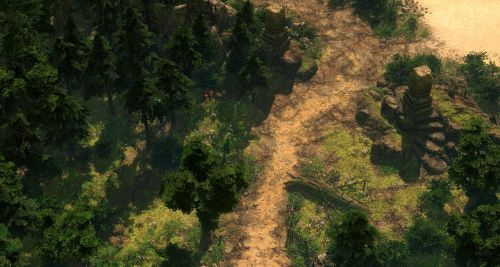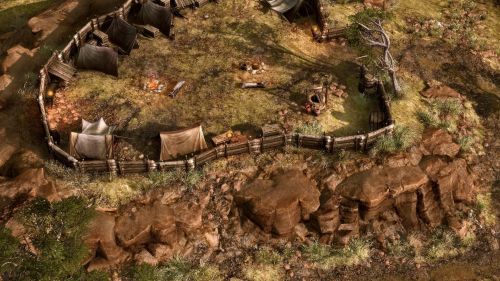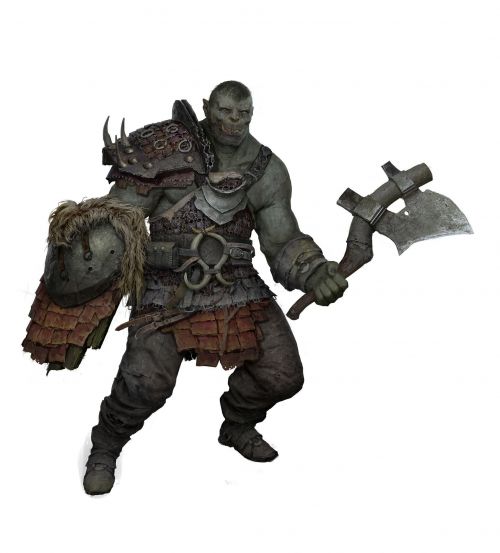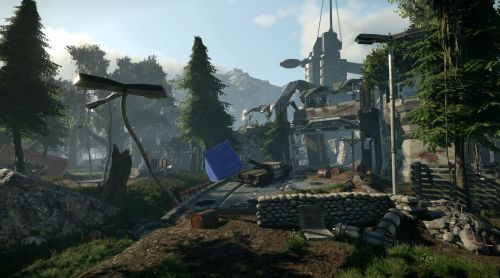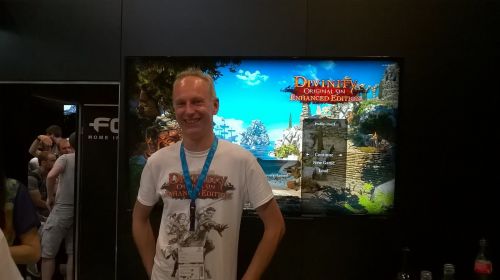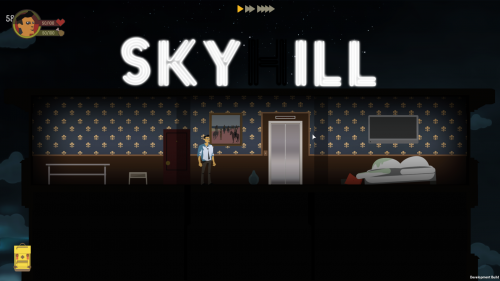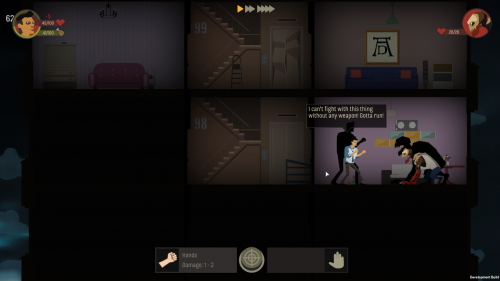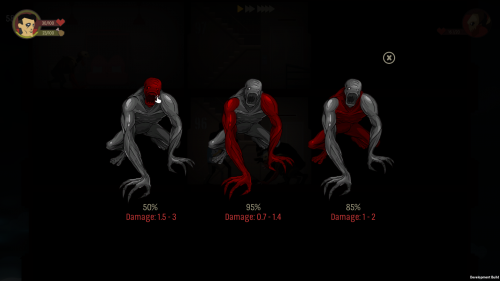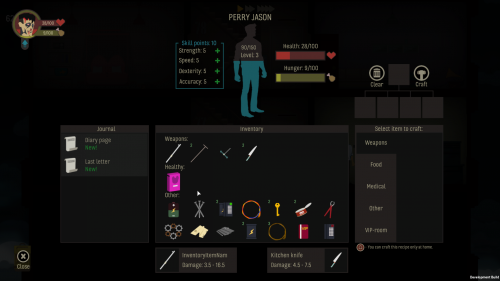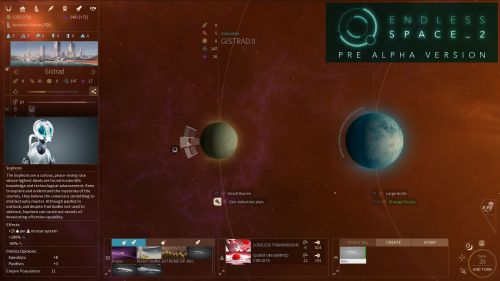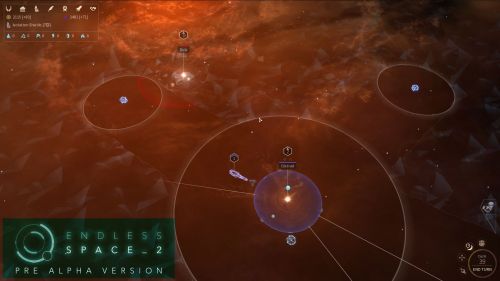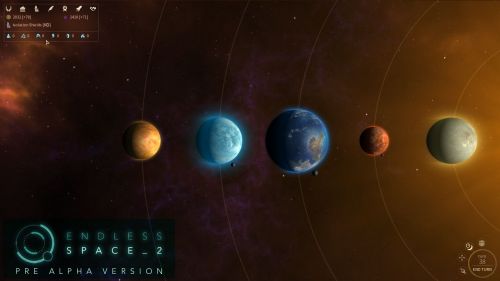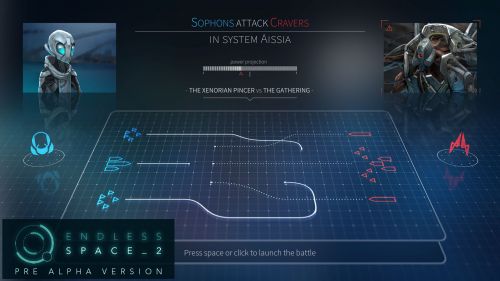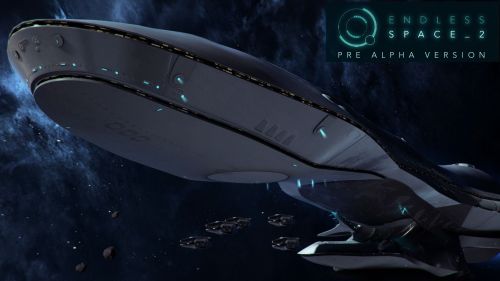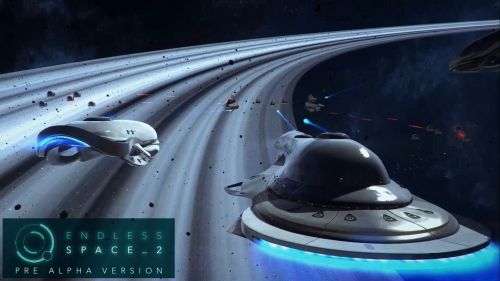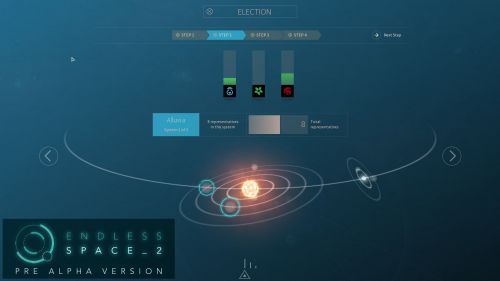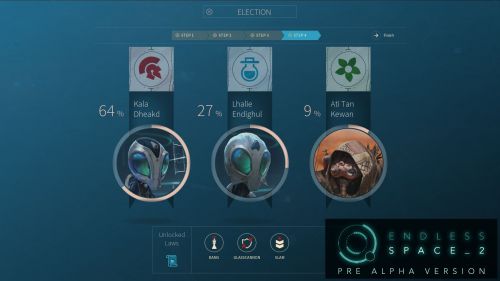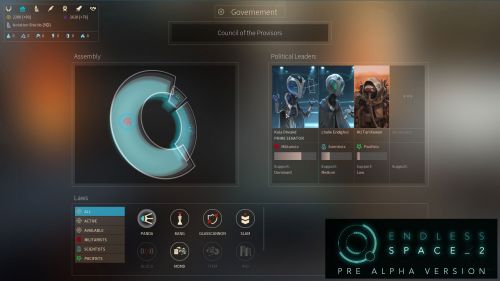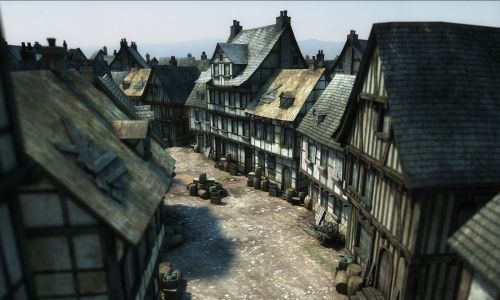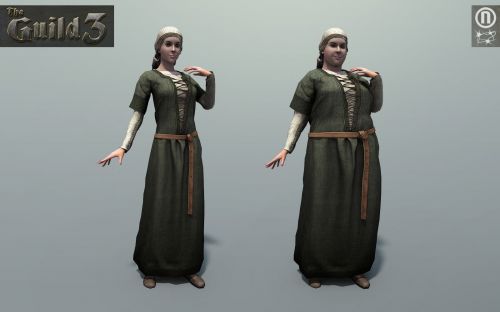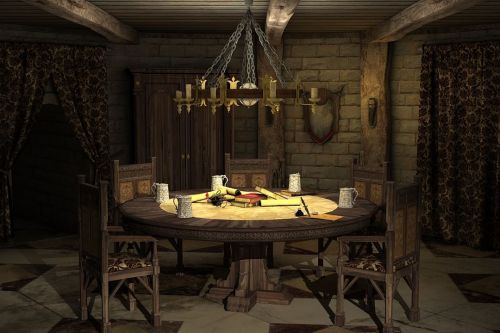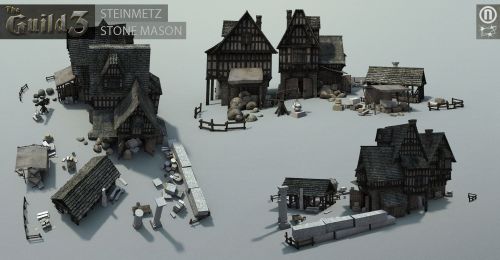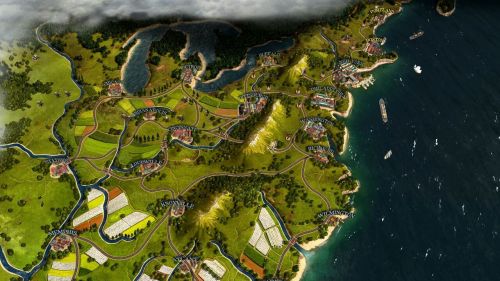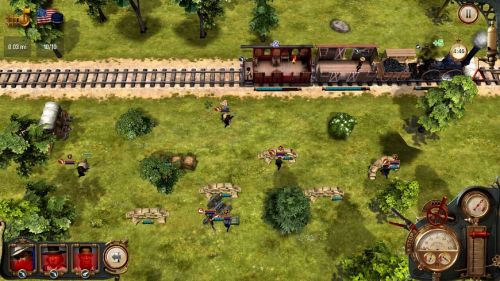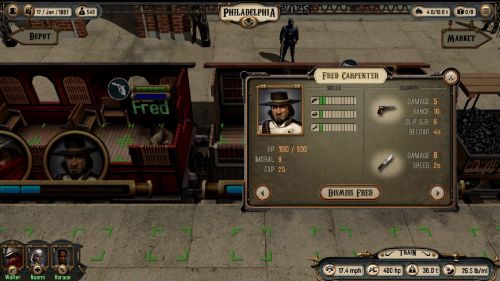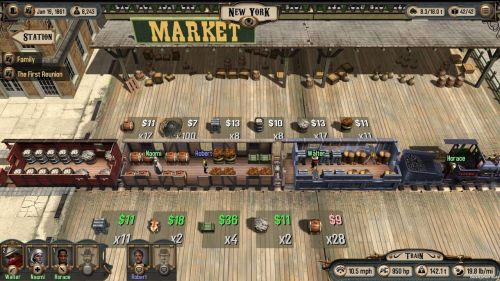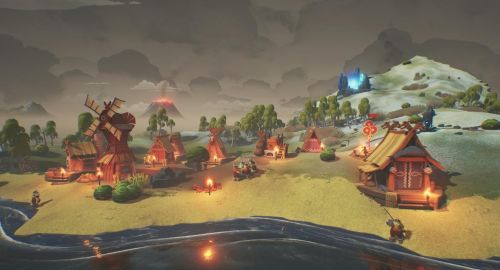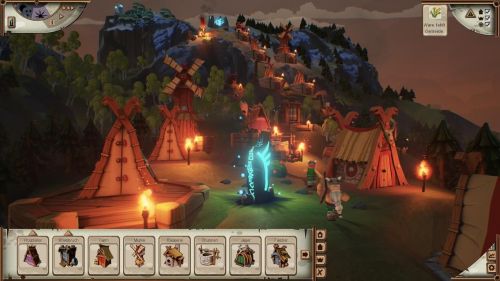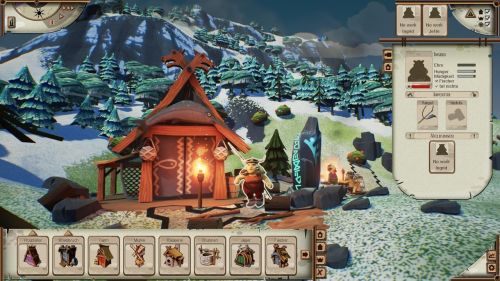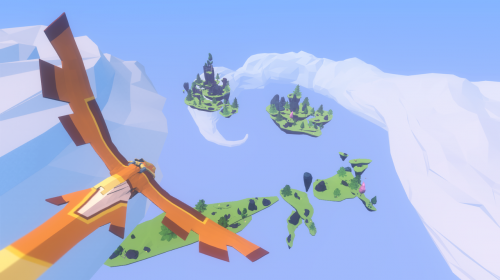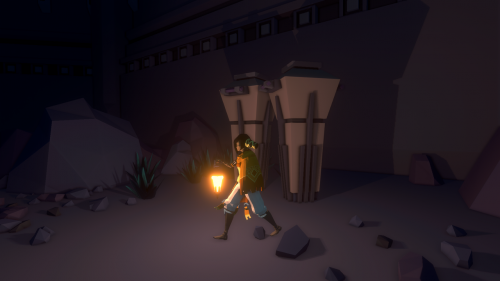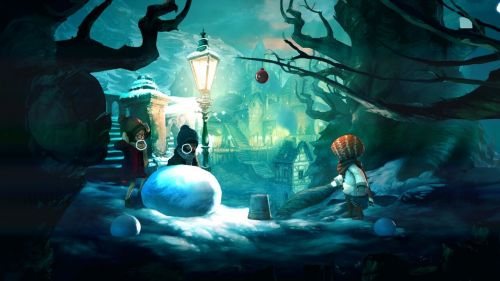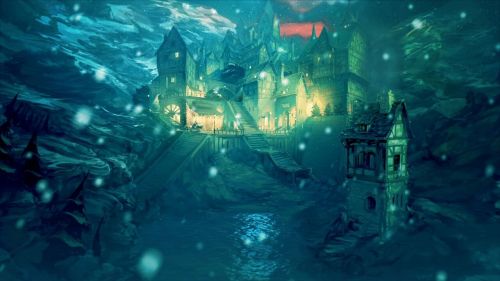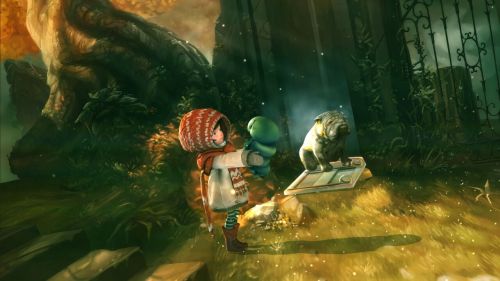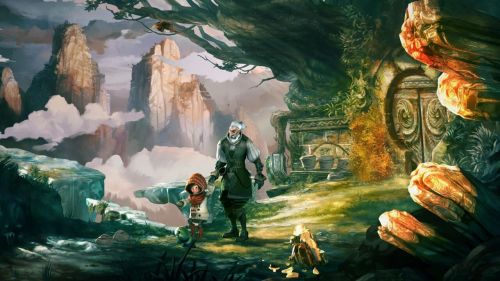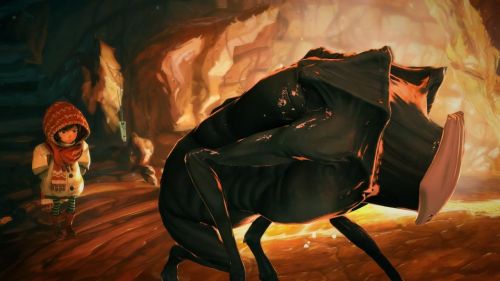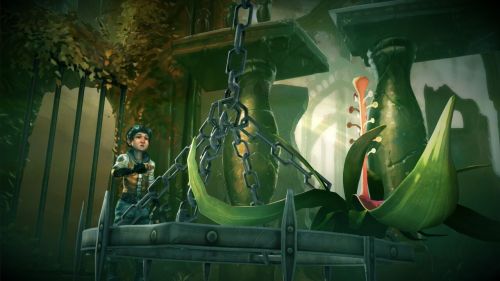RPG Codex Report: Gamescom 2015 - SpellForce 3, ELEX, D:OS EE, The Guild 3, Daedalic and more
RPG Codex Report: Gamescom 2015 - SpellForce 3, ELEX, D:OS EE, The Guild 3, Daedalic and more
Editorial - posted by Infinitron on Thu 10 September 2015, 20:18:24
Tags: AER; Amplitude Studios; Anuman Interactive; Artefacts Studio; Bounty Train; Chaos Chronicles; Corbie Games; Daedalic Entertainment; Demons Age; Divinity: Original Sin; ELEX; Endless Space 2; Forgotten Key; Funatics Software; Gamescom 2015; GolemLabs; Grimlore Games; Larian Studios; Mandragora; Microids; Pendulo Studios; Peter Ohlmann; Piranha Bytes; Silence: The Whispered World 2; Skyhill; Spellforce 3; Swen Vincke; Syberia 3; The ABC Murders; The Dungeon Of Naheulbeuk: The Amulet Of Chaos; The Guild 3; THQ Nordic; Valhalla Hills; Yesterday OriginsThe lion's share of the latest chapter of Bubbles' celebrated Gamescom chronicle is dedicated to Grimlore Games' SpellForce 3, the latest installment in the semi-obscure German RTS/RPG series, and an interview with its technical director, Codexer and former Chaos Chronicles lead Peter "Hobgoblin42" Ohlmann. Indeed, at one point it was supposed to be its own article. However, Bubbles decided that he had enough room left (and also that he wanted to get this shit over with already) and so he plumbed the depths of his Gamescom experience to give you, dear reader, our most extensive Gamescom writeup yet.
And I do mean "plumbed the depths". Starting from decent games such as Larian Studios' Divinity: Original Sin Enhanced Edition and Amplitude Studios' Endless Space 2, Bubbles worked his way through Piranha Bytes' ELEX, GolemLabs' The Guild 3, all the way down into the piles of shovelware from publishers Anuman Interactive and Daedalic Entertainment. But it's within Daedalic itself that he discovered the true heart of darkness, in a game called Silence: The Whispered World 2, sequel to 2009's The Whispered World. I quote:
And I do mean "plumbed the depths". Starting from decent games such as Larian Studios' Divinity: Original Sin Enhanced Edition and Amplitude Studios' Endless Space 2, Bubbles worked his way through Piranha Bytes' ELEX, GolemLabs' The Guild 3, all the way down into the piles of shovelware from publishers Anuman Interactive and Daedalic Entertainment. But it's within Daedalic itself that he discovered the true heart of darkness, in a game called Silence: The Whispered World 2, sequel to 2009's The Whispered World. I quote:
“You know this from the cinema.”
“There's no inventory; we want to make something simpler this time.”
“There will be puzzles, but they will be easy and streamlined.”
“It's trial without error; you can't do anything 'wrong'.”
“Experience the story!”
“Not everybody will like this.”
Silence is the sequel of The Whispered World, a charming little point and click adventure from a time when Daedalic were still capable of producing good and complex games on a small budget. And they didn't just make good games then, they also made them quickly: Chains of Satinav, a fine, well-crafted game with an impeccable sense of atmosphere, was released in June 2012, and its sequel Memoria came out just 14 months later in August 2013. Memoria had good gameplay and a great story; it's one of my favourite adventure games of all time. As recently as 2013, Daedalic seemed to be doing everything right. And then, they changed. It's hard to shake the feeling that something horrible and traumatic must have happened to these people, warping their company philosophy into something unrecognisable. Is this what going mainstream looks like? Daedalic is certainly not suffering from a lack of funding: Uli proudly declared that Silence was the developer's “biggest project to date”, having already spent four years in development and needing at least another half year to come out just right. For comparison: Broken Age took roughly three years to develop. Book of Unwritten Tales 2 took two and a half years and was 20 hours long. Four and a half years is an utterly absurd amount of development time for an adventure game from a large studio, especially from one that used to pride itself on quickly and cheaply producing very good games just two short years ago.
Where have all the money and effort gone? Into “the most beautiful trailer we've ever made at Daedalic... at least so far!” And into the in-game graphics, of course. Uli was not shy to point out how stunningly gorgeous the game was in every aspect of its existence: it was “on a whole different level of quality from [their] previous games, really detailed,” with “fantastic looking” 3D backgrounds (more precisely, projection mapped 2D images) “offering the perfect scenery to capture the characters and their emotions” by means of “emotional close-ups,” “fast cuts,” and “unique hand crafted animations,” with “seamless transitions between cutscenes and in-game scenes.” Of course the story will also be “so, so complex”, but this complexity is only made possible because the game just looks so damn gorgeous. With these brain meltingly beautiful graphics, Daedalic can emotionally engage the player on a whole new level, and truly immerse them in the action. All distracting and disruptive elements – otherwise referred to as "gameplay" – have been filed down to a minimum.
Read the full article: RPG Codex Report: Gamescom 2015 - SpellForce 3, ELEX, D:OS EE, The Guild 3, Daedalic, and more“There's no inventory; we want to make something simpler this time.”
“There will be puzzles, but they will be easy and streamlined.”
“It's trial without error; you can't do anything 'wrong'.”
“Experience the story!”
“Not everybody will like this.”
Silence is the sequel of The Whispered World, a charming little point and click adventure from a time when Daedalic were still capable of producing good and complex games on a small budget. And they didn't just make good games then, they also made them quickly: Chains of Satinav, a fine, well-crafted game with an impeccable sense of atmosphere, was released in June 2012, and its sequel Memoria came out just 14 months later in August 2013. Memoria had good gameplay and a great story; it's one of my favourite adventure games of all time. As recently as 2013, Daedalic seemed to be doing everything right. And then, they changed. It's hard to shake the feeling that something horrible and traumatic must have happened to these people, warping their company philosophy into something unrecognisable. Is this what going mainstream looks like? Daedalic is certainly not suffering from a lack of funding: Uli proudly declared that Silence was the developer's “biggest project to date”, having already spent four years in development and needing at least another half year to come out just right. For comparison: Broken Age took roughly three years to develop. Book of Unwritten Tales 2 took two and a half years and was 20 hours long. Four and a half years is an utterly absurd amount of development time for an adventure game from a large studio, especially from one that used to pride itself on quickly and cheaply producing very good games just two short years ago.
Where have all the money and effort gone? Into “the most beautiful trailer we've ever made at Daedalic... at least so far!” And into the in-game graphics, of course. Uli was not shy to point out how stunningly gorgeous the game was in every aspect of its existence: it was “on a whole different level of quality from [their] previous games, really detailed,” with “fantastic looking” 3D backgrounds (more precisely, projection mapped 2D images) “offering the perfect scenery to capture the characters and their emotions” by means of “emotional close-ups,” “fast cuts,” and “unique hand crafted animations,” with “seamless transitions between cutscenes and in-game scenes.” Of course the story will also be “so, so complex”, but this complexity is only made possible because the game just looks so damn gorgeous. With these brain meltingly beautiful graphics, Daedalic can emotionally engage the player on a whole new level, and truly immerse them in the action. All distracting and disruptive elements – otherwise referred to as "gameplay" – have been filed down to a minimum.
On my second day of Gamescom I attended presentations for 16 games of various genres. In addition to the RPGs, I also sampled as many strategy and adventure games as possible in order to satisfy the large and vocal audiences of our thriving sister sites Tacticular Cancer and AdventureDex. Since the amount of actual RPGs I saw that day was somewhat limited, I've decided to sort this batch of reports by genre instead of presenting them strictly chronologically.
My first sort-of-RPG of the day comes from a long and boring lineage. The first two Spellforce games were derivative and shallow action RPG/real time strategy hybrids; their modest success seemed to derive solely from the fact that they were made by German developers for German audiences. Of course, Spellforce 3 is going to be a high quality product with actually intellectually challenging elements that will be palatable for fans from all cultural backgrounds. Or at least that's was the game's technical director Peter Ohlmann – yes, the Peter Ohlmann, of Chaos Chronicles fame – tried to convey to me during our pleasant one-on-one presentation. Peter is also known as Hobgoblin42 on the Codex, although he doesn't put that on his business card.
Since I have the entire presentation taped, I might as well let Peter deliver the description of the game in his own (translated) words. Indeed, I found him to be a passionate monologist who employed the spoken language in the same way that we Codex front page writers use the written word; consequently, he had already gone quite hoarse by the time I visited him. Because Peter didn't actually have any gameplay footage or any videos to show me, I can just post a couple of screenshots alongside the text and give you the full presentation experience with only moderate effort on my part.
1. Graphics Style and Environmental Design
Peter: "As you can see, we've put a lot of emphasis on details in this game; the whole world is full of little things to discover. Sadly, this was also the idea for Chaos Chronicles: when you're playing through a map, you are able to find lots of little things, like NPC quest givers standing around in the forest, little chests, rocks that can be pushed around, small animals running through the landscape, snakes, frogs, that sort of thing. We want to bring back the spirit of Spellforce 1, which was much more of a labour of love than the second part, and want to supply hand crafted levels that allow the player to discover a huge amount of things.
"As you've already seen from the graphics, the art style of this game is much more serious and 'sober' than in the first two parts, which were very closely modelled after the style of the Warcraft games. You already know us from Jagged Alliance [more precisely, JA: Back in Action] and Chaos Chronicles, so you know that we're not exactly thrilled about that kind of style. We going more in the direction of Lord of the Rings instead, a little more serious and credible. For us, fantasy is something that should be taken seriously. These kinds of ironic jokes like in Divinity – some people like 'em, but we're not the biggest fans. A fantasy game must take itself seriously within its game world in order to be credible.
2. Gameplay Basics; Building Sim Gameplay
"Spellforce gameplay is based on three pillars: the building sim part, the military part, and the RPG part, with a party of heroes. [At this point, I wonder out loud if this isn't too much for one game.] Well, from the perspective of the developer it's an enormous amount. You have to develop almost three games. But that's Spellforce, and we have to live with that. The building sim part has gone through the biggest changes compared to the earlier games. It used to be a fairly simple building system, more reminiscent of Warcraft and Starcraft then of the Anno or Settlers series. Our building system has become much more challenging and complex, and also takes up a bigger chunk of gameplay time. Our maps are similarly large as those in Spellforce 2, occasionally even larger, but are partitioned into small sectors. These sectors are marked with small border stones, and the player can expand his territory and move the border, a bit like in Civilization or Settlers. At the start, however, these sectors are occupied by various monsters and enemies, maybe a nest of spiders or a bandit camp. That means the group of heroes will have to clear the sectors of enemies before they can occupy them; this works a bit like in Company of Heroes. Then you can build your outpost. As soon as that outpost is up and running, the sector will become a part of your territory and the player can start placing buildings.
"There are 3 factions in the base game: humans, elves, and orcs. You'll play all of them during the course of the campaign, multiple times in fact. Per faction, you have up to 20 buildings, and these sectors can be freely built upon. There are up to 6 types of resource on each map; wood, stone, food – food can be harvested in many different forms –, iron ore, lenya, and moon silver. The last two are Spellforce-specific resources; you may know them from the previous games. Every sector has a different set of resources, like in the Catan board games. For example, there's a barren mountain sector in the north, which has iron but nothing else; another sector has meadows for grazing but offers no other resources, and another has a lake for fishing. Like in board games, you have to take a good look around the map and see which sectors are needed in the long term; and then you expand your realm according to your needs.
"All of the sectors have the outpost, which can be upgraded; it's a kind of storage area. You hire workers in the sector, which then work automatically; you assign them to their jobs, but everything else is managed by the sector itself. If a woodcutter runs out of trees to chop in his area, you don't have to take care of him yourself; all that stuff is automated. The workers then bring all their goods into this sector, and the sectors are connected by roads; these roads appear once a sector is added to your realm. The roads are used by ox carts, which move your goods between the sectors. For example, the mountain sector in the north will supply you with iron ore; you can't immediately use the ore, so it's transported by ox carts to the south. There's an iron smelter there that creates iron bars, and the iron bars are once again transported by ox carts to… let's say the centre, where the smithy and the barracks are. And there the military unit will be produced.
"Now, while the ox cart is travelling around, it might pass through dangerous territory, so you will have to make sure to A: protect your trade routes, and B: occasionally build a tower or do an escort quest. Because naturally there's going to be some bandits and goblins who like to roam the countryside and who might attack unguarded ox carts. This whole building sim part with the sectors and this new transport and logistics system is a novelty for Spellforce. We think it brings back some depth to the gameplay, especially in the building aspect, which was rather a bit too shallow in Spellforce 2 and was massively criticised.
"These maps are quite time intensive. They aren't something you complete in an hour or two; these are big strategy maps, where you build up your own realm and build up the logistics. You'll need two to three hours to fully complete them. You can also return to these maps again after you've left. Maybe you'll find a dungeon that you can't enter at first, but later on you'll remember about it, send your heroes inside, and are now able to, for instance, open a gate. The maps are not 100% persistent. Once you've conquered the map and own everything, there won't be any further evolution. If you return you'll find the same people as before, who basically keep on running the settlements by themselves and hail you as the great liberator. You'll only come back to access the previously inaccessible locations.
"Here we see a sector before the player has conquered it – unfortunately, you can't see the sector borders in this shot. This place was inhabited by bandits, and we just killed those guys and will have to destroy their camp to take the sector for ourselves. These shots are from the DirectX 9 version by the way; we've only just moved to DirectX 11 and can't show everything off in that version yet.
3. Action RPG Gameplay and Character System
"Occasionally you'll find sectors on the maps that don't offer anything to your economy, but which may have, for example, a special location. Perhaps it'll be an entrance to an abandoned dwarven mine. You can't send your army or your workers in there, but your heroes – which are always with you – can enter that dungeon while the game is running. And then the game loads a real dungeon level, and your party of heroes plays through that dungeon. The dungeon level will offer typical RPG elements, like finding and disarming traps, picking locks on doors, solving puzzles and riddles, interacting with NPCs, really doing quests in these dungeons, and of course fighting enemies and getting loot. Once you're finished this... let's call it an "intermezzo-dungeon", you'll return directly to the strategy map and continue it where you left off.
"Now, there's also dungeons on these maps that directly influence the events above ground. For instance, you will find the magical hip bone of the lizard shaman, which you then return to the lizard people, a neutral faction on the map. These lizard people will of course be super happy, and they will ally with you, so you can use them against the enemy, who'll be somewhere on the map as well, doing his thing. That way, the RPG intermezzo-level, which is basically an action RPG with puzzle elements, influences the outcome of the strategy map.
"The character system is based on traditional classes like Wizard, Rogue, Paladin, Cleric, and Fighter. In total, you have up to eight character classes to choose from, each of them with different skill trees. These trees are gradually unlocked as you level up. After a certain point you'll unlock premium classes that you can add to your character, like multiclassing in D&D. You'll make a Rogue-Warlock, or a Figher-Cleric, whatever you want. Of course this isn't D&D, it's a real time combat system; we've thought this up ourselves. However, the classes are based pretty closely on the standard western RPG classes, and those are ultimately based on D&D after all. Your party can include up to five characters, but your avatar will be the only character that is fully customized and levelled up from the start by the player. The other party members will join your party Baldur's Gate style, each following their own agenda; some of them will be familiar faces from the previous Spellforce games.
4. RTS Combat Gameplay
"I wanted to say a little bit more about the military system; of course it's a classic RTS system, but compared to the first two games we've significantly increased the amount of tactical gameplay. I once made a game named Knights and Merchants that took place in the Middle Ages, and for Spellforce 3 we also decided that our big battles, which involve many more soldiers than before, would be more similar to the strategic battles of the Middle Ages. We now have four types of weapons: cavalry, archers, pikemen, and sword fighters. These four types of weapons work in a rock/paper/scissors system with different strengths and weaknesses, and have a greater impact on the outcome of a battle compared to the earlier games.
"First of all, the heroes are no longer so overpowered as in the other games: they can no longer defeat armies on their own. Secondly, it's really extremely important how the army is positioned at the start of combat. This is a bit of a reference to Knights and Merchants, but also to Warhammer, classical table top games, or also Total War games. In our game it can be devastating if enemy cavalry – for example, orcish wolf riders – basically trample your archers into the ground because they're unprotected, then the battle is practically lost. Similarly, it can happen that your pikemen catch the enemy cavalry with their pants down, then you'll celebrate a triumphant victory, or when your sword fighters disable the enemy pike men to clear the path for your cavalry.
"Using the environment is now also much more important. You have higher ground and lower ground, similar to Starcraft; archers that shoot down a mountain will do much more damage than archers who want to shoot up a mountain. We also have fog of war that prevents you from seeing what's on top of a plateau, unless you either send a flying unit to scout around or walk up there yourself. These tactical factors – the environment and the enemy weapon types – will make all of the battles in Spellforce much more tactical and challenging than in the predecessors. You'll really have to tinker around a bit.
"There are up to 12 units per faction. There are the base units, who are designed after those medieval unit types; they aren't identical between factions, but very similar. And then there are special unit types in every faction, like orc shamans for example. There's a flying unit in each faction, and there's a titan, already known from the first two games. These titans require an enormous amount of resources to be built. It's a little like a world wonder in Civilization, but it's a very aggressive world wonder. As soon as you've built a titan, in single- or in multiplayer, that's usually the beginning of the endgame. Unless both sides send their titan against each other and they destroy each other...
"Here we see an orc warrior. Our orcs aren't those green dumbasses who chug beer all the time and yell at everything, but we present them as a nomadic people who live in the savannah and have their own culture and language; they're people you can reasonably interact with. They aren't morons like in Warhammer, they're really a full fledged playable faction."
5. Campaign Design and Storytelling
"Of course there's also a world map. In contrast to the previous games, you can freely decide which territories you want to conquer first. Ultimately, you have to conquer almost everything, but you can make your own decisions about the order of doing things. The story and the campaign are 'half linear': you can make a few decisions that determine which map you play the next story mission on. Frankly, the end result [of beating each alternative map] is always the same, but you will be able to follow different [paths] to get there. You'll also have lots of dialogues with emissaries of the different factions, and you'll be able to decide for or against factions. This also influences the maps you play on, and how the alliances on those maps will be set up. So you can decide in favour of a tribe of orcs, who will then help you against the elves, or you can do it the other way around.
"Your world map is a 2D view of all the territories you can explore or return to, and there's also a hub, your own castle, your headquarters. This is pretty much a "real" RPG level with characters standing around: there'll be craftsmen and scientists who can develop new technologies, making your iron mine more efficient, improving your ox carts, your pikemen, or your archers. There are also story NPCs, the faction emissaries will be lounging about the place, and there's also an Enchanter. He'll take items you found in the dungeons and basically 'disenchant' them, which will increase his skill and will eventually allow him to actually enchant items for you. Of course there's also a trader and a trainer, who'll teach you new skills; this hub level will always be your home. You also have a world map like in Skyrim [I assume he means Dragon Age: Inquisition] lying on a table in your hub, so you can look at it and decide where to send your troops next.
"Each of your companions also has their own epic quest – you're free to do those or leave them be, they're optional –, and they also have their own political convictions. Spellforce 3 is quite a political game compared to its predecessors, a little bit like Game of Thrones. For example, the back story is much more political; it's no longer about good versus evil, or human against dragon, or orcs against elves. The primary focus is really the politics in this country, in the Kingdom of Latander. And in this Kingdom, different people have different plans. Some support the ruling queen, others would like nothing more than to brand her as a heretic or burn her at the stake. Religions also have different influences – I don't want to spoil too much –, but politics in general play a much more important role.
"You're going to have NPC dialogues with real consequences; depending on the dialogue's outcome, you're going to make new allies or enemies on your next map. The characters are also less black and white than in Spellforce 1. There are shades of grey, and you never quite know what kind of game someone's playing. It's heavy on the intrigue, more Game of Thrones than classic Spellforce, because we wanted to grow up a little bit. You know, even back then I think it was a little silly when some dragons were chit-chatting with each other – that kind of thing is out. We also don't have the problem that we need to take the previous games as a foundation, because we're actually a prequel. So we don't have to use all those characters and all those elements; Shaikan – some sort of dragon blood warriors – those didn't even exist at the time. In their place we have other elements that we're casting a little more light on.
"One example: in Spellforce 1 and 2 there was this mysterious, ancient people of the Shapers, a civilization that was technologically much further developed than the other peoples on the planet on which Spellforce takes place. There are basically only ruins left of the Shapers now, standing around in the landscape. These remnants – these artefacts and ruins – will also play a role during the campaign. They are already a part of the story in Spellforce 1 and 2, but these games don't tell you nearly as many things about the Shapers as we do."
6. A Short Interview
Thus concluded Peter's presentation. You may have wondered why I let the man speak for so long in a one-on-one setting without interrupting him with any of our patented Complex Codex Questions. The simple answer is that I find it very difficult to become excited for hybrid games of any kind. When you smush two genres together in a single game, it seems almost inevitable that some of the deeper elements from each genre will be diluted, resulting in a shallow and muddled implementation of gameplay systems. And if, like Peter's and his colleagues, you actually need to combine three genres and stage them within the deeply lame Spellforce setting – well, how could such a game possibly turn out to be any good at all?
Still, Peter had said some things that gave me a faint measure of hope. The promise of actual tactical combat would already make for a big, positive change from the previous Spellforce games, as would the implementation of D&D-esque classes and multiclassing. The stated intention to ignore some of the most clichéd elements of the predecessors (like dragons and people born of “special blood”) in favour of a supposedly complex political plot was also reasonably appealing. But were these aims actually achievable for such a deeply hybridised game? Could the developers go both broad and deep? Oh, and didn't German games generally have a bit of a writing problem as well? I had about three minutes left to find out!
Bubbles: Let's talk about clichés – does the story once again feature an ancient civilization that comes back to life, that somehow comes out of its ruins, as part of the main story?
Peter: Well, whether it's coming back to life, I really cannot say; I'm not spoiling anything anyway. We've only taken this people [the Shapers] into the game, because it's really very important for the background story of the first two games. We wanted players who were familiar with those games to feel at home in Spellforce 3, and give them the chance to get answers to some open questions. We're not introducing a massive amount of extra lore, because the campaign focusses on politics. We focus on the intrigues that influence the politics of the day, and less on the epic background. On the other hand, these ghosts of the past will nonetheless play an important role. I won't tell you to what an extent, but it's not a cliché that we've introduced, because the Shapers were always present in the setting.
Bubbles: How is it going with your publisher? I've heard a lot of praise for Nordic Games from the Guild 3 devs; was your experience similar? Can you talk well with them?
Peter: Compared to our previous partners, who are well known [bitComposer], we now have the opportunity to work as an internal studio of Nordic Games and actually invest the necessary time and manpower into the project. It's no longer an adversarial relationship – as is often the case in a pure developer-publisher relationship –, but we trust each other, we all have full transparency with our costs, and we can decide on our own what we invest in the game and how we invest it. Nordic Games have made it clear from the start that the “Spellforce” brand must be… “resurrected” is perhaps too harsh, but that we must at least deliver a Spellforce project that is really fully convincing. We all know, at the publisher and at the developer, that the last Spellforce add-ons – although we did not have anything to do with them – did not reach the level of quality necessary to maintain a brand like Spellforce on the market. But I think that with our history and with our genre expertise, we will be able to let Spellforce shine in its full glory.
But it is also absolutely clear, also for our publisher, that Spellforce is, in terms of features and gameplay, an enormous monster that needs to be vanquished. Thus, we need to keep a realistic view of the development capacities and the development time, because we want to and have to deliver pretty much full fledged games for all three parts of Spellforce 3 – the building sim, the RTS, and also the RPG. So basically, "viel Feind, viel Ehr." [This roughly translates as "the more danger, the more honour."] I'm confident that both we as the developer and Nordic Games as the publisher will make the right decision.
Bubbles: And the release date is pretty much fixed as it stands?
Peter: Uhmmm, what release date? [laughs] Well, we're looking at end of 2016. That's a current projection for when we'll come out either with a beta or with an Early Access build, it's not yet clear. We're going to definitely need some sort of beta for our rather complex multiplayer online system, because we are much more ambitious in this area than the previous games were. Next to the PvP mode we also have a PvE mode, where you can play through new dungeons with your own online heroes and really level them up online, similar to closed Battle.net. [Jesus Christ!]
Bubbles: Yet another new feature!
Peter: Exactly, but we're very engaged with this, and we will have to keep an eye on making sure that we can finalise this with the level of quality that we have in mind. Delivering a Spellforce that doesn't satisfy the fans is not helpful to anybody.
Bubbles: No. But you've taken on quite a big project here.
Peter: Yes, of course, yes. But as an internal studio, as I said, there are other economic possibilities as opposed to a studio that signs a contract with a publisher and has to deliver something within 1.5 years, which could barely be projected in advance, if at all. It's really a different story now, because we're really pulling the same rope together and Nordic games also have an interest in making the Spellforce brand shine in its old glory, so that it can celebrate a revival, a comeback.
Bubbles: Thank you! That all sounds great!
Peter: Okay.
In summary: there's some potential here, but none of it has been realized yet. With an ambitious feature set and a highly dubious heritage, Spellforce 3 seems like the kind of development project that will reward every last ounce of money and effort that its developer and publisher are willing to pour into it. Fortunately, the developer's strong vision for the project and the franchise's inexplicable hit status in Germany may actually make such an undertaking possible. Spellforce 3 may even offer an RPG experience that's vaguely relevant to Codex interests; it's simply too early to make a judgement when there is so little of the game to see and so many complex features left to implement.
7. Chaos Chronicles / Demons Age
Before the Spellforce 3 presentation had officially begun, Peter and I had found a few minutes to talk about the latest developments regarding Chaos Chronicles, the cancelled "Temple of Elemental Evil homage” that Peter had worked on at his previous studio. Mr. Ohlmann had genuine news for me on this front, and I felt it appropriate to repay the favour by forcing CC fans to scroll past all his Spellforce 3 stuff to find out about it. First off, he relayed fresh news about the Portuguese RPG Demons Age. DA's developer Bigmoon Studios had caused a moderate frenzy on our forums in July when they were caught blatantly re-using Chaos Chronicles assets in the first screenshots for their new game. The Chaos Chronicles assets were actually tied up in a complicated legal dispute between Peter's defunct development studio and a defunct publisher, bitComposer. Peter had just gotten off the phone with the “remnants of bitComposer” and they had come to an agreement with Bigmoon; the CC assets would no longer be used in Demons Age. Mr. Ohlmann also mentioned that, as far as he had been informed by the Bigmoon people, Demons Age would be using the 3.5th edition rules without implementing any skills or traits. I got the feeling that my interview partner was a little disappointed by this development. Keep in mind, however, that this is all second hand information from a former competitor with an obvious personal attachment, so we may wish to seek clarification from Bigmoon through a Codex-exclusive interview at some point.
Peter was also quite keen to keep the Chaos Chronicles flame burning despite all odds – possibly because it was the only game of his that had attracted a significant following of hardcore fans. He mentioned Pierre Begue's Knights of the Chalice and the challenges of developing a game that fully complied with the Open Game Licence; the game of Peter's dreams would fully comply with the OGL, be easily moddable, follow up on the old school ideals of Chaos Chronicles and KotC, and quite possibly be a terrible commercial flop. Personally, I imagine that quite a few people dream of a game like this, but nobody's making it. Perhaps Pierre Begue will save us once again.
The new game from Piranha Bytes had made quite a positive impression on the Codex when it had first been announced, although I couldn't quite understand why. The developers hadn't made a good game since Gothic 2, which was released 13 years ago; since then, their games had gradually become worse and worse, culminating in the truly horrible Risen 2 and 3, which were two of the most wretchedly inane RPGs in recent memory. After personally slogging through most of Risen 2, I had absolutely no faith left that these people were capable of producing anything interesting or entertaining anymore. And yet, the Codex community was still interested in their games. And so I went, and suffered.
Unsurprisingly, this was one of the most boring presentations of Gamescom. Our presenter was a sleepy dude named Michael Paeck (the game's Producer, formerly of JoWood Productions), who seemed unable to muster any enthusiasm for the game whatsoever; and really, who can blame him? First, he rattled down the basic information about the game: ELEX had been in development for 1.5 years and should take another 1.5 years until release. The game was set on a planet “like Earth, but not the Earth”, which had been populated by various technologically advanced societies when a terrible catastrophe struck. About a hundred years ago, the planet had experienced an apocalyptic meteor impact, which had wiped out a chunk of the planet's population. Many of the survivors were in the thrall of the titular drug ELEX, which had been derived from the meteor's fragments. ELEX endowed its users with great powers, but robbed them of all empathy and emotion, “like the White Walkers in Game of Thrones.” The (always male) protagonist was a former ELEX user who had lost his supply of the drug and could now experience emotions for the first time – even love.
In terms of gameplay, ELEX would be a "refinement" of Piranha Bytes's established formula. The game would be roughly 70 hours long and feature the typical open-world gameplay of the Risen and Gothic games. Most NPCs could be killed, but not all; meanwhile, dialogues would be highly interactive, “inspired by The Witcher 3.” Halfway through the game, you would have to join one of three major factions, who would help you progress to the endgame. There were the Outlaws, an “anarchic Mad Max faction in the desert” who wanted to destroy all traces of the drug, the Clerics, who considered anything related to ELEX to be “evil”, and the Berserks, who rejected modern technology, but did use ELEX. As usual, you could work with each faction for a while before having to make your final decision. Beside the joinable factions, there were also the evil and tyrannical ELEX-using Albs; the player character had grown up among the Albs, but it didn't seem like he could stay with them during the game. In terms of weapons, ELEX offered not only the classic range of medieval weaponry, but also high-tech equipment like laser guns.
After this brief introduction, Michael showed us a bit of gameplay footage. First, he demonstrated the game's biggest new innovation: the jetbelt. Now you could fly up and down for a while whenever you wanted; this would be very helpful with exploration. The presenter demonstrated this cool new mechanic by stepping off a steep mountain ledge and gently floating into the forest below. Michael called this “base jumping.” Then, he showed off ELEX's combat. The protagonist walked up to a huge dinosaur-like creature and started to swing his sword around. The dino squeaked like a rubber ducky, and a little red health bar popped up over its head. The hero kept swinging; the dino kept squeaking; the health bar kept going down. Then the dino collapsed and the hero sheathed his sword. Evidently, Piranha Bytes have elected to stick with their proven combat system from the Risen games.
Michael announced that the minimal UI from the combat scene – just the enemy health bar, nothing else – would be prototypical for the final game; the GUI would be reduced to its absolute bare minimum to achieve total immersion in the game world. To that end, every menu in the game would actually be presented within the world as a holographic projection from the protagonist's trusty PipBoy-equivalent. How cool was that? He couldn't show us any menus yet, but they were assured to look most immersive indeed. Finally, Michael assured us that ELEX was being developed for all platforms simultaneously, because porting the games from the PC to consoles “had never worked out” for the developers. On that happy note, I began to ask my questions:
Bubbles: You haven't said a word about character development or stats yet. Are there actually stats in this game?
“Of course, but we really want to keep the abstraction to a minimum.” Michael elaborated that there would be some stats – damage numbers on weapons, for instance – but that the game was not “stat heavy.” He assured me that players could still learn new skills from trainers in the game world, which was a really immersive way of handling stat progression. That's all the details I could get out of him.
Bubbles: Why did you choose the name ELEX for your game? It's a very odd sounding name; it sounds like the name for a drug.
“Well, that's exactly what it is! It is a drug!” [I phrased my question sloppily, so he deserved that victory.] Then Michael elaborated. There were two key factors that inspired them to choose the name ELEX:
1) Symmetry: “'ELEX' works very nice symmetrically; it has 2 'E's and an 'X' at the end.”
2) Availability: “When you make a new game, you want to choose a title that you can really own. It's getting harder and harder today to find a unique name that's still available on sites like twitter and facebook. 'ELEX' was still available.”
And that was all we had time for. The presentation did absolutely nothing to improve my opinion of Piranha Bytes as a studio, nor of ELEX as a game; maybe our resident Risen 2 and 3 fans will feel differently. To me, it looks like the developers are simply picking up where they left off with Risen 3, just with a “cooler” setting and with a focus on minimizing abstract elements like the GUI and character stats in favour of "maximizing immersion." I cannot see any reason to get excited about that.
If you've read our report on D:OS 2, you already know that Larian like to demo co-op gameplay with controllers in their presentations. This type of gameplay may not be particularly relevant to Codex interests, but it seems to do a great job at winning over gamers who normally aren't interested in hardcore PC RPGs. The group in my presentation was packed with those people: 6 out of 8 attendees hadn't played D:OS before, and I was the only one who had finished it. Our host was a pale giant with a bewildering accent who introduced himself as “Swen”; I astutely deduced that this man was Larian's CEO Swen Vincke. Swen quizzed me on my credentials: “Really? You finished the game?” I admitted that I hadn't really had much of a choice in the matter: my community had given a lot of money to the D:OS Kickstarter, and so I was duty bound to see if the money had been well spent. That's how Swen knew that I was from the Codex.
The actual presentation was not very informative for people who were familiar with the game. Swen's partner had blundered into the SparkMaster 5000 fight with only three characters in his party and asked Swen for help. Mr. Vincke went to Arhu, fetched the remote control (now featuring a brand new GUI with cute little faces instead of the old text interface) and came back to help his partner, who was fighting the robot at the same time. While his character was trekking to the SparkMaster's cave, Swen briefly summarized the biggest improvements of the Enhanced Edition: full controller support, improved co-op functionality, fully voiced dialogues, improvements to the main story (particularly in the third act), more items, more spells, better balance, a reorganized spell and ability progression, and better enemy AI. Swen never got to use the remote: by the time he was ready to act, the booth staff had pushed through the door and reminded him that he was running overtime. As his final move, Swen steered his character into a patch of ice and let her fall flat on her ass; that seemed like a very Larian thing to do.
The audience were massively entertained by all of this – by the co-op shenanigans, by Swen's mantra of “if it works, it's not an exploit”, by the cute faces on the remote, and maybe even by the turn based combat. It was the second most well received presentation I would see at Gamescom, dwarfed only by the Fallout 4 event on Friday. After it was all over, Swen had to pose for pictures for his adoring fans, and I tried to sneak in a few questions while the staff was staring daggers at us. I got as far as asking him what the biggest improvement in the EE was (“The AI”) before he cleverly purchased his escape by inviting us to come to Ghent in two weeks. Thus, all was well; the console crowd had witnessed the marvels of co-op gameplay, Larian had gained at least 6 new customers, and the Codex had secured a D:OS 2 presentation.
I sampled this game in the booth of French publisher Anuman. Anuman was by far the most frugal and cost efficient publisher I met at Gamescom: their tiny presentation booth consisted of nothing but a cheap table surrounded by empty cardboard boxes, five rickety chairs, and a minifridge full of power drinks for bribing sceptical attendees. The presentations were held by means of an ancient laptop, on which one of the presenters was showing off VLC videos while his colleague introduced the games. I say “games” because the presenters forced me to suffer through their entire Microids portfolio (including shovelware like The ABC Murders, Moto Racer 4, and Syberia 3) before I could finally get my five minutes of Dungeon of Naheulbeuk footage.
DoN is a genre parody RPG in the vein of The Bard's Tale (2004) and Frayed Knights. It's directly based on the script of a crowdfunded international TV show (still in development), which is in turn based on a series of old French audio webisodes. The game's developer Artefacts Studio had previously worked on a bunch of casual DS games, making this their most ambitious project by far. You may wonder why the hell I would even bother with this kind of game; the simple answer is that it offered turn based isometric party combat, and I felt morally obligated to give it at least a little bit of Codex Coverage. The presentation was extremely short, but I still learned a few things: DoN is a dungeon crawler with a huge party of at least seven pre-defined adventurers (all taken from the TV show and webisodes, of course), who each have their own set of active abilities during combat. The demo footage showed 7 ability slots for each character, and it looked like the system was cooldown based. The game is full of “humorous” voiced party banter, and the combat floats are “funny” and “unique” as well; every time a character killed an enemy, the message “EPIC WIN” would float across the screen. Release of DoN is planned for 2017, one year after the debut of the TV show. To be honest, the whole thing looked terribly unfunny to me; maybe the French humour just got lost in translation. At least the ability-based combat seemed to be more complex than in Wasteland 2.
I saw this tiny side-scroller roguelike late in the afternoon as part of Daedalic's publisher portfolio; it was presented by its developer Eugene Kisterev, who hailed from the fair country of Russia. Skyhill has a simple premise: the player character starts on the 100th floor of a spooky luxury hotel that has been invaded by strange mutated creatures. The objective is to fight your way to the bottom floor and escape the hotel alive. Gameplay consists of turn based battles against one of eight different creature types; players can also target different enemy body parts through a VATS-like interface. The game will have a simple xp-based leveling system, with four player stats that can be raised to improve a character's combat performance. As you go through the hotel, you can unlock new starting abilities for your next playthrough, which encourages exploration; however, every room you enter also decreases your character's “hunger” stat. Thus, you constantly have to find food and "fill the hunger bar" to stay alive. Hunger seems to be the main resource of the game; when your character is low on health, you can take the elevator back up to your hotel room and convert spare “hunger points” into health by sleeping. As you progress through the game, you can also unlock optional starting conditions like bulimia to make your next run more "fun". Finally, Eugene showed off a few rudimentary inventory puzzles that also allowed for weapon crafting (“kitchen knife + stick + scotch tape = spear”). This mechanic could potentially add another layer to the gameplay, though the examples I saw were not particularly complex.
Over the course of the presentation, I noticed that Eugene seemed to have a rather troubled relationship with the English language. The game was stuffed with swear words like “fuck” and “shit” that didn't really add much to the atmosphere, and when I tried to question the developer about the strange health numbers in the demo build (health points ranged from 1 to about 30, but damage was calculated with two decimals, so you could have an enemy with 23.61 health) he absolutely could not understand what I was talking about. Moving on, Eugene explained that the main character was a billionaire named “Perry Jason”, who lived in a country called “New Europa” that was ruled by the “Confederates”, who were currently fighting in World War 3. The developer seemed to have put a lot of careful thought into the setting; he promised that plenty of newspaper clippings and journal entries would be found throughout the game to further flesh out the backstory. To top it all off, presented us with a shot of the hotel's neon sign; the letter “H” was broken, and the sign now read “SKY ILL”. He seemed very proud of that shot.
Skyhill's “unique” writing style might make for a fun thirty minutes of play time, but I didn't see any evidence of the kind of deep and interesting mechanics that usually attract me to roguelikes like ToME and DC:SS. This is a much simpler game than its freely available competitors, but – crucially – it's coming on the market with a launch price of 14.99€. I don't think Eugene is doing himself any favours with that price, and I don't quite understand why a publisher like Daedalic even picked this game up. Then again, Daedalic have been making plenty of bad decisions recently, as you may learn in the adventure game section of this fine article. Skyhill will be released on the 6th of October of this year, after 1,5 years of development time (6 months of it full time). There's now a demo available on the game's Steam page; if you play that, you can probably get most of the Skyhill experience for free after all.
My first appointment on Thursday morning was a visit to the extraordinarily lively Amplitude booth. This visit proved in many ways to be a perfect counter to our HoMM 7 interview from the previous evening. Superficially, the two game were quite similar; both Heroes 7 and Endless Space 2 were PC-exclusive turn based strategy game sequels, and they were both being handled by French PR teams (Amplitude is an indie that was formed by ex-Ubisoft staff). However, whereas Ubisoft's people had been enveloped in a heavy shroud of desperation, loneliness and misery, the Amplitude guys were a chatty and energetic bunch who seemed to thrive on the constant attention of their booth visitors. They genuinely seemed to care about their games. When I arrived, I was immediately greeted by a frighteningly young staffer, who led me to a massive tablet of delicious pastries (five different types!) and presented me with a choice of various beverages. Then he began to gently quiz me on my knowledge of Amplitude's previous games; meanwhile, other staffers, who were handling other visitors, were in constant orbit around us, occasionally interrupting our conversation to offer their own views on the subjects we were discussing. There was an endless stream of drinks, food, and conversation about video games; I could have stayed in that booth for the rest of the morning. It seemed the most pleasant place in all of Gamescom.
Of course, one side benefit of stuffing your visitors' mouths with pastries is that you can prevent them from asking too many probing questions; besides, it's hard to flip through a notebook with sticky fingers. Thus, I spent about half of my 15 minutes in the waiting area just making small talk about Endless Legend while munching on a delicious Danish. Thankfully, I eventually remembered my journalistic duties and dredged up a few prepared questions from the deeper recesses of my memory.
Bubbles: You're using the same setting for all of your games [Endless Space, Dungeon of the Endless, Endless Legend], and you show direct connections between the games in your PR stuff – like the ES2 teaser, which shows a spaceship from one of the EL victories. But you're making games in different genres: Dungeon is a roguelike, and the other two are 4X games. Do you expect that people will care enough about the Endless setting to play games from genres that don't interest them?
My handler answered that Amplitude was using the Endless setting primarily because they enjoyed making games in it. They liked building on the lore and making cross-connections between the games – all of that was simply fun for them. Amplitude included these things in their PR materials because their fans might also find them fun. They didn't believe that these connections alone could convince a die hard 4X player to try out a roguelike, but if that did happen, it would surely be a nice side effect. As to why they had made a roguelike? Because they thought roguelikes were fun.
Bubbles: So what inspires you to make a new game, or a game in a new genre?
His first answer, of course, was “fun”. However, Amplitude were also very mindful of the graphic design of their games, and took that into account when discussing new game ideas. My handler had particular praise for one of the graphic designers on the staff, who had done such a good job on one of their previous titles [I'm 90% sure that it was Dungeon of the Endless; sugar clouds the mind] that the team wanted to make a new game built around his art style. Of course, he currently had no further details to offer on that game.
At this point we were cut short [a recurring theme at Gamescom] and my small group of three visitors was invited into the presentation booth, where I met ES2's lead director Romain de Waubert and his colleague Max. Romain's first action was to welcome us all; his second was to offer me a refill on my drink. The Amplitude staff seemed determined to be the perfect hosts, and they were succeeding. The actual presentation was unfortunately heavily based on moving pictures and various graphical effects; Amplitude tried to work around this by including a ton of high quality gifs in my press kit, but they're a poor substitute for the real thing. Thankfully, you can watch one of the presentations on youtube instead and get just about the same information as I did.
I'll give you a brief summary of my impressions: ES2 is marketed as an evolution of ES1 with the added improvements of Endless Legend, like increased differentiation between factions and a robust quest system. Romain also demonstrated a new political system, which includes parliamentary factions, demographic preferences and the option to implement policies based on your current dominant faction; it vaguely reminded me of the Victoria games, which is not a bad thing at all. Taken together, all of these additions should go a long way towards making ES2 more complex and dynamic than its rather repetitive predecessor. The game seemed to have a pleasantly playful atmosphere as well, with policy names like “SLAM – Selective Attack Maximization for Imperial Glory Order (+100% damage on fleets).” With the terribly uninspired Beyond Earth still fresh in my mind, it felt particularly nice to meet a group of 4X developers who were still capable of having some fun with their setting. Like its predecessor, Endless Space 2 will use an indirect combat system; all the battles will be auto-resolved through cutscenes. This type of simplification didn't really bother me in ES1, but I know that there are a few people who will once again feel disappointed by the lack of a proper Master of Orion-style space combat system.
The focus on art design, on the other hand, is a cause for concern. Romain asserted that Amplitude's games in general were “not about the numbers”; their chief goal was to “create an atmosphere” and immerse the players in the world by minimizing the interface. This sounded very similar to what the ELEX guy had been saying, with the key difference that Amplitude had actually made good and entertaining games within the last 12 years. As such, I'm willing to give them the benefit of the doubt with their PR talk. Besides, where the ELEX guy could merely offer a meek “all your menus will be in-world projections” quote, the Amplitude people were aiming at something that was potentially much more interesting: they wanted to turn the space bar into an “alternative view” button, which could be pressed at any time during gameplay to give a different perspective on the data shown in the main view. In practice, that usually meant flooding the screen with a slew of extra information about the planet or the culture you were currently inspecting, which is certainly a laudable addition to the gameplay. Of course it might have been even better to just cram all the information into the main screens to begin with, abandoning the casual gamers to navigate the sea of data on their own; alas, Amplitude is not a developer who would make that kind of game. ES2 is planned to hit Early Access in 2016 and go to full release before the end of the year.
Finally, there was time for a short question, and I had a nice one:
Bubbles: In the first game, some players complained about hordes of ships fighting with each other, while other players complained about too much granularity [in the fleet mechanics]. How are you planning to address these issues? (Raghar)
The devs went “uhm” and “ahhh” at that question; finally, Max said: “don't spoil!” Unfortunately, Erwain took his colleague's warning to heart and dropped only vague hints about the future of the fleet mechanics: they were working on a system that was going to be “super fun [...] if everything works out.” This system would “allow [fleets] to really be specialized interactively” for players who wanted complexity. Casual players, on the other hand, would be provided with “tools for simplification.” The vagueness was not appreciated, but at least the phrasing was encouraging: the system seemed to be designed with hardcore players in mind first and foremost, with the option to be simplified for casual tastes, rather than the other way around. However, the developers stressed that this would not make ship management a major aspect of the gameplay; they estimated that you would “still spend 80% of your time managing your empire.”
That seemed a positive enough note to take my leave on. Before we left, the devs gave each of us a key for the Endless Pack (lowest recorded Steam price: 39.99€) and Romain handed us his business card for any further questions. The Amplitude staff were really remarkably good at PR; thankfully, their game also looked promising on its own merits.
I feel like this presentation might have gone better if I hadn't made two terrible mistakes. Mistake number one was asking the presenters to speak English, even though we all spoke German. It made sense at the time – it's much easier to get accurate quotes for the Codex if you don't have to translate everything – but in retrospect it really hurt the flow of the presentation. Halfway through, the presenters actually asked me to pose my questions in German, so that they could understand me more easily and then answer me in English. Thankfully, the experience was so uncomfortable that I swiftly noticed my error; for the remainder of my stay at Gamescom, I never insisted on an English-language presentation again.
My second mistake was more relevant to the game itself. The Guild 3 comes from a franchise with a long and difficult history; the first Guild game (also known as Europa 1400) was released in 2002. It was a complex medieval life sim with a style that vaguely reminded me of Darklands. Your character could choose to pursue a variety of professions, covering a wide range from the mundane (baker or thief) to the outlandish (gypsy magician, necromancer). Getting better at your chosen job was a core part of the gameplay, but you also had options for murdering opponents, building your own dynasty, or waging legal campaigns at the court house. The game had a remarkable sense of atmosphere; its scope was regulated in just the right way to be fun, complex and immersive without degenerating into a sprawling city sim. The game was quite buggy, but that never bothered me much because it was fun. Four years later, the same development studio released The Guild 2; it was a horrendously buggy mess that replaced the gloomy low-polygon towns of the first game with oversized bloom-drenched cityscapes. The first game had relied on sparse graphics and a few pieces of fine 2D art to work its charm; its successor went all out on the 3D and looked the worse for it. Whatever strange magic had endowed the first game with so much atmosphere was missing from The Guild 2; I played it for an hour and then never touched it again. And so, when the presenters asked me about my experience with the previous games, I gave them my honest opinion.
It cannot be understated how much an honest statement of one's preferences can ruin a presentation. While the two presenters were still ignorant of my personal opinion, they seemed highly motivated to convince me of their game's qualities; but when I told them that I considered The Guild 2 to be an inert pile of soulless trash, they sighed in bitter defeat. After the presentation was over, one of the presenters (Heinrich Meyer, a producer from Nordic Games) caught me in the hallway and explained the situation: the target audience for The Guild 1 had been made functionally irrelevant by the progress of time. He knew that people like me were still out there, watching and waiting for something reasonably Guild 1-like to come out of the franchise again, and he even had some measure of sympathy for my plight: it turned out that Heinrich was the only remaining member of the original Guild 1 team who was still affiliated with the franchise. Sadly, by some cruel twist of fate, The Guild 2 had actually attracted a sizeable fan base; Heinrich estimated that Guild 2 fans currently outnumbered Guild 1 fans 2:1. Thus, there was no profit in making a game for Guild 1 fans anymore. Guild 3 was being designed for Guild 2 fans first and foremost.
And so I sat in the presentation room, virtually predestined to be disappointed by the game, while the presenters put on a brave face and explained the biggest improvements over The Guild 2 to me. The franchise had lost both its original developer 4HEAD and its original publisher JoWooD. Losing 4HEAD was a problem that was expertly solved by bringing in GolemLabs, who had previously developed the Superpower games. GolemLabs seemed like an eminently competent developer; they were building The Guild 3 from scratch in a new engine, but the alpha version already looked uncannily like The Guild 2 (at least to my untrained hateful eyes). Losing JoWooD, on the other hand, had not been so great a problem. Heinrich assured me that the new publisher Nordic Games (i.e. his employer) was a professional company who had a genuine interest in producing good games. This had already made a major difference in the development process. The Guild 3 would quite literally be bigger and better than its predecessor; it had the largest city maps in the series (“Make them smaller!”, I thought. “Smaller!”), it had theoretical support for 32-player multiplayer (this was not final, and I didn't give a toss about it anyway), and it featured an extremely powerful editor that would allow for a thriving modding community. The official scenarios (12 were planned for launch) would offer free-roaming gameplay, with the only story elements deriving from mini-quests; however, the mod tools were strong enough that even complex historical events like an outbreak of the plague could be recreated in detail by intrepid community members.
Heinrich and his colleague from GolemLabs then proceeded to demonstrate some of the functions of the editor: they drew footpaths and streets on the map, placed buildings and upgraded them on the fly, and even tweaked the growth cycles of barley by making it grow in May instead of July. Everything but the terrain itself could be modified with this single tool. If somebody used modded files to create a scenario, the editor would automatically include all the mods in the scenario file; thus, you could just upload a single file to the Steam Workshop without having to worry about your users missing any relevant mod files. The editor also used a new approach to scripting that (supposedly) greatly reduced the likelihood of bugs. Meanwhile, the multiplayer mode was completely script free, which made it far more stable. The editor and the script improvements are clearly the major draws of The Guild 3; this is a game that will stand and fall with its modding community. Unfortunately, that community will be chiefly comprised of The Guild 2 fans, so the game's success is still very much in doubt. The Guild 3 is planned to enter beta stage at the end of this year.
This is an easy one to describe: it's like Pirates! but on a train, set in the US of the Civil War era. The game features a pretty overland map, a vast array of faithfully recreated historical train components, and more randomly generated escort and delivery quests than you can shake a stick at. There's also a bit of a main plot – something about a man inheriting his father's train and trying to reunite his scattered family – but you'll spend most of the game doing side quests. Bounty Train is a roguelike with permadeath; thus, you must take great pains to protect your main character and his faithful train companion. You defend the train from bandits and other scum by hiring escorts and ordering them into battle in real time; other game mechanics include explosive cargo and train fires, which you should take care to keep separate from each other at all times. Overall, the game looked polished and competently made; if the pitch appeals to you, you'll probably enjoy playing this. Currently in Early Access at an outrageous price point.
Another easy one: this is a greatly simplified version of the Settlers and Cultures games. It's made by a man named Thomas Häuser, who has worked as a lead developer on both series and is now well past his prime. Guide your vikings from the start portal to the end portal of each level by building up a settlement and then sitting at your keyboard until your Vikings have gathered enough resources to progress. All the levels are randomly generated, and you play through them in endless mode until you fail a map or grow bored with the interminable repetition. There are certain achievements like “chop 500,000 blocks of wood” that will unlock permanent upgrades that apply to all your playthroughs. I rather like this type of unlock mechanic, but not enough to make me play this game. Valhalla Hills started production in January of this year, and will release in early 2016. It entered Early Access two weeks ago. After Skyhill and Bounty Train, this is the third game in this report that costs more than it should; all three games are being published by Daedalic. Coincidence? I don't think so.
Described by its developer as “creating the experience of flying”, this game is about flying a girl named Auk around a bunch of floating islands to a soothing soundtrack. The devs don't know if you can die yet. The presenter had a hard time finding anybody who wanted to do a hands-on for him. His victim promptly discovered the secret secondary gameplay element: you can walk into caves and sneak around behind rocks to “hide from the old god.” The purpose of doing this is still unclear. Also published by Daedalic; the price hasn't been announced yet, but my prediction is 39.99€. The game's title is a pun.
Another Microids game. Miserable trash. Imagine a low budget version of Frogware's Sherlock Holmes: Crimes & Punishments aimed at the casual crowd. There's a rip-off of the “deduction web” with two options instead of sixteen, and a puzzle that requires to you walk through the door that somebody just told you to walk through. I'd say this was aimed at children, but it's a murder mystery. Avoid at all costs.
The sequel to “Yesterday” by Pendulo Studios, which I never played. The presentation footage actually looked quite fun; the sample puzzle involved breaking out of jail by rubbing a prison guard's cup with a hallucinogenic toad and lifting up a pig with a pulley to make the guard see a flying demon pig. Playful and nonsensical – not bad at all. YO also has a unique visual style: the act of hoisting the pig was broken up into small panels that animated in sequence. Apparently, “Yesterday” was only 3 hours long and very easy; if you're interested in the sequel, you'd best wait and see if it's worth the price.
The final Microids title. Supposed to be hotly anticipated, though I've never met a fan. Features a dialogue wheel; four options were the maximum shown in the demo. The inventory is lined up along the left edge of the screen (think Telltale's The Walking Dead) and shows four items at once. Graphics are pretty, but there were no puzzles shown. The protagonist (Crystal? Rachel? April?) walked through a tribal hut full of yak-like entities and talked to an old ethnic woman about the latest local news. Sample line of dialogue: “She's working with a certain colonel to send me back to the US.” Pulse pounding fun. Music by the composer of Fallout, meaning Inon Zur. Only for die-hard Syberia fans, poor bastards.
“You know this from the cinema.”
“There's no inventory; we want to make something simpler this time.”
“There will be puzzles, but they will be easy and streamlined.”
“It's trial without error; you can't do anything 'wrong'.”
“Experience the story!”
“Not everybody will like this.”
With this game, Daedalic finally jump on the Telltale bandwagon. Mind you, Silence is not one of those cheaply made episodic titles that Telltale crank out by the dozen: this is a proper story experience with ultra high quality visuals, delivered in a single 10 hour instalment. Silence is a real interactive movie. It's an extremely linear movie, of course: game director Uli Wanitschke was very clear about the fact that Silence will NOT feature any sort of long term consequences, nor even bother to create the illusion of a real branching narrative. The player will occasionally have choices in dialogue, but they will “branch out for a very short time only, quickly show some sort of consequence, and then immediately rejoin the main story.” The honesty, at least, is refreshing. But why even offer choices then? Because they give the player a chance to make “emotional decisions” and feel more involved in the story. Uli gave an example of a player who thinks "I wanna lie now!" Choosing to lie won't actually impact the plot in any way, but the player will feel like a liar, and that's what's important in this type of game. This is how these choices look in practice: you see a long cutscene featuring the two protagonists, a brother-sister couple named Sadwick and Renie, and Spot, Renie's pet blob (i.e. the comic relief character). At some point, they are presented with a problem and make a choice; that's when a dialogue box with two options pops up. The options are written as if you, the player, were really speaking them out load. That's how Daedalic recreates that fevered atmosphere in the cinema where you're just shouting at the screen in a high-pitched frenzy: “Sadwick, fire the cannon!”, or: “Renie, send Spot!” Option one appeals to players who want to be aggressive and take charge of a situation, while option two resonates with people who also want to assert themselves, but in a peaceful and cooperative way. After you've made your choice, whichever character you empowered with your words will briefly take charge, solving the situation in their unique way. This is total immersion; it's like the characters in the movie are really reacting to what you're saying. Naturally, Silence will feature a highly engaging plot that has been designed to appeal to players of all ages: the game revolves about a little girl who is trapped in a dream world between life and death, and her older brother who tries to find and protect her. According to Uli, the game's ending will be both perfect and mind blowing.
Silence is the sequel of The Whispered World, a charming little point and click adventure from a time when Daedalic were still capable of producing good and complex games on a small budget. And they didn't just make good games then, they also made them quickly: Chains of Satinav, a fine, well-crafted game with an impeccable sense of atmosphere, was released in June 2012, and its sequel Memoria came out just 14 months later in August 2013. Memoria had good gameplay and a great story; it's one of my favourite adventure games of all time. As recently as 2013, Daedalic seemed to be doing everything right. And then, they changed. It's hard to shake the feeling that something horrible and traumatic must have happened to these people, warping their company philosophy into something unrecognisable. Is this what going mainstream looks like? Daedalic is certainly not suffering from a lack of funding: Uli proudly declared that Silence was the developer's “biggest project to date”, having already spent four years in development and needing at least another half year to come out just right. For comparison: Broken Age took roughly three years to develop. Book of Unwritten Tales 2 took two and a half years and was 20 hours long. Four and a half years is an utterly absurd amount of development time for an adventure game from a large studio, especially from one that used to pride itself on quickly and cheaply producing very good games just two short years ago.
Where have all the money and effort gone? Into “the most beautiful trailer we've ever made at Daedalic... at least so far!” And into the in-game graphics, of course. Uli was not shy to point out how stunningly gorgeous the game was in every aspect of its existence: it was “on a whole different level of quality from [their] previous games, really detailed,” with “fantastic looking” 3D backgrounds (more precisely, projection mapped 2D images) “offering the perfect scenery to capture the characters and their emotions” by means of “emotional close-ups,” “fast cuts,” and “unique hand crafted animations,” with “seamless transitions between cutscenes and in-game scenes.” Of course the story will also be “so, so complex”, but this complexity is only made possible because the game just looks so damn gorgeous. With these brain meltingly beautiful graphics, Daedalic can emotionally engage the player on a whole new level, and truly immerse them in the action. All distracting and disruptive elements – otherwise referred to as "gameplay" – have been filed down to a minimum. With simple 1-click controls and no inventory, the gameplay in the demo footage boiled down to three different types of actions:
1) Keep left clicking on a hotspot to see the character try various carefully animated solutions until they find one that works.
2) Watch a hook swing back and forth across the screen and click on it when it's right over the character's head.
3) Select one of two dialogue options and watch a two-minute cutscene unfold.
If you like the idea of an animated children's movie you can watch on your PC, then you might as well buy Silence and contribute to the rapidly progressing decline of the adventure genre in the process. If, on the other hand, you prefer your games to have some measure of actual gameplay, then you should stay the hell away and punish these miserable hacks for trying to peddle their overproduced trash to the adventure gamer audience. Silence: The Whispered World 2 is currently in parallel development for PC, Mac, Linux, Xbox One, and PS4. Release is planned for 2016, but you shouldn't be surprised if it slips into 2017.
Next up: oh sweetest of joys – there's still one Daedalic game left! The penultimate instalment of this venerable series will feature Project Daedalus, Hard West, XCOM 2, Fallout 4, and The Mandate. Or in other words: one game that has a lot of potential, one that seems quite decent, one that looks utterly mediocre, and two games that represent everything that's wrong with the gaming industry; that's better than the Gamescom average. But which game is which? Come back in a week to find out!
I – RPGs, Hybrids and Roguelikes
Spellforce 3 + Chaos Chronicles/Demons Age
Spellforce 3 + Chaos Chronicles/Demons Age
My first sort-of-RPG of the day comes from a long and boring lineage. The first two Spellforce games were derivative and shallow action RPG/real time strategy hybrids; their modest success seemed to derive solely from the fact that they were made by German developers for German audiences. Of course, Spellforce 3 is going to be a high quality product with actually intellectually challenging elements that will be palatable for fans from all cultural backgrounds. Or at least that's was the game's technical director Peter Ohlmann – yes, the Peter Ohlmann, of Chaos Chronicles fame – tried to convey to me during our pleasant one-on-one presentation. Peter is also known as Hobgoblin42 on the Codex, although he doesn't put that on his business card.
Since I have the entire presentation taped, I might as well let Peter deliver the description of the game in his own (translated) words. Indeed, I found him to be a passionate monologist who employed the spoken language in the same way that we Codex front page writers use the written word; consequently, he had already gone quite hoarse by the time I visited him. Because Peter didn't actually have any gameplay footage or any videos to show me, I can just post a couple of screenshots alongside the text and give you the full presentation experience with only moderate effort on my part.
1. Graphics Style and Environmental Design
Peter: "As you can see, we've put a lot of emphasis on details in this game; the whole world is full of little things to discover. Sadly, this was also the idea for Chaos Chronicles: when you're playing through a map, you are able to find lots of little things, like NPC quest givers standing around in the forest, little chests, rocks that can be pushed around, small animals running through the landscape, snakes, frogs, that sort of thing. We want to bring back the spirit of Spellforce 1, which was much more of a labour of love than the second part, and want to supply hand crafted levels that allow the player to discover a huge amount of things.
"As you've already seen from the graphics, the art style of this game is much more serious and 'sober' than in the first two parts, which were very closely modelled after the style of the Warcraft games. You already know us from Jagged Alliance [more precisely, JA: Back in Action] and Chaos Chronicles, so you know that we're not exactly thrilled about that kind of style. We going more in the direction of Lord of the Rings instead, a little more serious and credible. For us, fantasy is something that should be taken seriously. These kinds of ironic jokes like in Divinity – some people like 'em, but we're not the biggest fans. A fantasy game must take itself seriously within its game world in order to be credible.
2. Gameplay Basics; Building Sim Gameplay
"Spellforce gameplay is based on three pillars: the building sim part, the military part, and the RPG part, with a party of heroes. [At this point, I wonder out loud if this isn't too much for one game.] Well, from the perspective of the developer it's an enormous amount. You have to develop almost three games. But that's Spellforce, and we have to live with that. The building sim part has gone through the biggest changes compared to the earlier games. It used to be a fairly simple building system, more reminiscent of Warcraft and Starcraft then of the Anno or Settlers series. Our building system has become much more challenging and complex, and also takes up a bigger chunk of gameplay time. Our maps are similarly large as those in Spellforce 2, occasionally even larger, but are partitioned into small sectors. These sectors are marked with small border stones, and the player can expand his territory and move the border, a bit like in Civilization or Settlers. At the start, however, these sectors are occupied by various monsters and enemies, maybe a nest of spiders or a bandit camp. That means the group of heroes will have to clear the sectors of enemies before they can occupy them; this works a bit like in Company of Heroes. Then you can build your outpost. As soon as that outpost is up and running, the sector will become a part of your territory and the player can start placing buildings.
"There are 3 factions in the base game: humans, elves, and orcs. You'll play all of them during the course of the campaign, multiple times in fact. Per faction, you have up to 20 buildings, and these sectors can be freely built upon. There are up to 6 types of resource on each map; wood, stone, food – food can be harvested in many different forms –, iron ore, lenya, and moon silver. The last two are Spellforce-specific resources; you may know them from the previous games. Every sector has a different set of resources, like in the Catan board games. For example, there's a barren mountain sector in the north, which has iron but nothing else; another sector has meadows for grazing but offers no other resources, and another has a lake for fishing. Like in board games, you have to take a good look around the map and see which sectors are needed in the long term; and then you expand your realm according to your needs.
"All of the sectors have the outpost, which can be upgraded; it's a kind of storage area. You hire workers in the sector, which then work automatically; you assign them to their jobs, but everything else is managed by the sector itself. If a woodcutter runs out of trees to chop in his area, you don't have to take care of him yourself; all that stuff is automated. The workers then bring all their goods into this sector, and the sectors are connected by roads; these roads appear once a sector is added to your realm. The roads are used by ox carts, which move your goods between the sectors. For example, the mountain sector in the north will supply you with iron ore; you can't immediately use the ore, so it's transported by ox carts to the south. There's an iron smelter there that creates iron bars, and the iron bars are once again transported by ox carts to… let's say the centre, where the smithy and the barracks are. And there the military unit will be produced.
"Now, while the ox cart is travelling around, it might pass through dangerous territory, so you will have to make sure to A: protect your trade routes, and B: occasionally build a tower or do an escort quest. Because naturally there's going to be some bandits and goblins who like to roam the countryside and who might attack unguarded ox carts. This whole building sim part with the sectors and this new transport and logistics system is a novelty for Spellforce. We think it brings back some depth to the gameplay, especially in the building aspect, which was rather a bit too shallow in Spellforce 2 and was massively criticised.
"These maps are quite time intensive. They aren't something you complete in an hour or two; these are big strategy maps, where you build up your own realm and build up the logistics. You'll need two to three hours to fully complete them. You can also return to these maps again after you've left. Maybe you'll find a dungeon that you can't enter at first, but later on you'll remember about it, send your heroes inside, and are now able to, for instance, open a gate. The maps are not 100% persistent. Once you've conquered the map and own everything, there won't be any further evolution. If you return you'll find the same people as before, who basically keep on running the settlements by themselves and hail you as the great liberator. You'll only come back to access the previously inaccessible locations.
"Here we see a sector before the player has conquered it – unfortunately, you can't see the sector borders in this shot. This place was inhabited by bandits, and we just killed those guys and will have to destroy their camp to take the sector for ourselves. These shots are from the DirectX 9 version by the way; we've only just moved to DirectX 11 and can't show everything off in that version yet.
3. Action RPG Gameplay and Character System
"Occasionally you'll find sectors on the maps that don't offer anything to your economy, but which may have, for example, a special location. Perhaps it'll be an entrance to an abandoned dwarven mine. You can't send your army or your workers in there, but your heroes – which are always with you – can enter that dungeon while the game is running. And then the game loads a real dungeon level, and your party of heroes plays through that dungeon. The dungeon level will offer typical RPG elements, like finding and disarming traps, picking locks on doors, solving puzzles and riddles, interacting with NPCs, really doing quests in these dungeons, and of course fighting enemies and getting loot. Once you're finished this... let's call it an "intermezzo-dungeon", you'll return directly to the strategy map and continue it where you left off.
"Now, there's also dungeons on these maps that directly influence the events above ground. For instance, you will find the magical hip bone of the lizard shaman, which you then return to the lizard people, a neutral faction on the map. These lizard people will of course be super happy, and they will ally with you, so you can use them against the enemy, who'll be somewhere on the map as well, doing his thing. That way, the RPG intermezzo-level, which is basically an action RPG with puzzle elements, influences the outcome of the strategy map.
"The character system is based on traditional classes like Wizard, Rogue, Paladin, Cleric, and Fighter. In total, you have up to eight character classes to choose from, each of them with different skill trees. These trees are gradually unlocked as you level up. After a certain point you'll unlock premium classes that you can add to your character, like multiclassing in D&D. You'll make a Rogue-Warlock, or a Figher-Cleric, whatever you want. Of course this isn't D&D, it's a real time combat system; we've thought this up ourselves. However, the classes are based pretty closely on the standard western RPG classes, and those are ultimately based on D&D after all. Your party can include up to five characters, but your avatar will be the only character that is fully customized and levelled up from the start by the player. The other party members will join your party Baldur's Gate style, each following their own agenda; some of them will be familiar faces from the previous Spellforce games.
4. RTS Combat Gameplay
"I wanted to say a little bit more about the military system; of course it's a classic RTS system, but compared to the first two games we've significantly increased the amount of tactical gameplay. I once made a game named Knights and Merchants that took place in the Middle Ages, and for Spellforce 3 we also decided that our big battles, which involve many more soldiers than before, would be more similar to the strategic battles of the Middle Ages. We now have four types of weapons: cavalry, archers, pikemen, and sword fighters. These four types of weapons work in a rock/paper/scissors system with different strengths and weaknesses, and have a greater impact on the outcome of a battle compared to the earlier games.
"First of all, the heroes are no longer so overpowered as in the other games: they can no longer defeat armies on their own. Secondly, it's really extremely important how the army is positioned at the start of combat. This is a bit of a reference to Knights and Merchants, but also to Warhammer, classical table top games, or also Total War games. In our game it can be devastating if enemy cavalry – for example, orcish wolf riders – basically trample your archers into the ground because they're unprotected, then the battle is practically lost. Similarly, it can happen that your pikemen catch the enemy cavalry with their pants down, then you'll celebrate a triumphant victory, or when your sword fighters disable the enemy pike men to clear the path for your cavalry.
"Using the environment is now also much more important. You have higher ground and lower ground, similar to Starcraft; archers that shoot down a mountain will do much more damage than archers who want to shoot up a mountain. We also have fog of war that prevents you from seeing what's on top of a plateau, unless you either send a flying unit to scout around or walk up there yourself. These tactical factors – the environment and the enemy weapon types – will make all of the battles in Spellforce much more tactical and challenging than in the predecessors. You'll really have to tinker around a bit.
"There are up to 12 units per faction. There are the base units, who are designed after those medieval unit types; they aren't identical between factions, but very similar. And then there are special unit types in every faction, like orc shamans for example. There's a flying unit in each faction, and there's a titan, already known from the first two games. These titans require an enormous amount of resources to be built. It's a little like a world wonder in Civilization, but it's a very aggressive world wonder. As soon as you've built a titan, in single- or in multiplayer, that's usually the beginning of the endgame. Unless both sides send their titan against each other and they destroy each other...
"Here we see an orc warrior. Our orcs aren't those green dumbasses who chug beer all the time and yell at everything, but we present them as a nomadic people who live in the savannah and have their own culture and language; they're people you can reasonably interact with. They aren't morons like in Warhammer, they're really a full fledged playable faction."
5. Campaign Design and Storytelling
"Of course there's also a world map. In contrast to the previous games, you can freely decide which territories you want to conquer first. Ultimately, you have to conquer almost everything, but you can make your own decisions about the order of doing things. The story and the campaign are 'half linear': you can make a few decisions that determine which map you play the next story mission on. Frankly, the end result [of beating each alternative map] is always the same, but you will be able to follow different [paths] to get there. You'll also have lots of dialogues with emissaries of the different factions, and you'll be able to decide for or against factions. This also influences the maps you play on, and how the alliances on those maps will be set up. So you can decide in favour of a tribe of orcs, who will then help you against the elves, or you can do it the other way around.
"Your world map is a 2D view of all the territories you can explore or return to, and there's also a hub, your own castle, your headquarters. This is pretty much a "real" RPG level with characters standing around: there'll be craftsmen and scientists who can develop new technologies, making your iron mine more efficient, improving your ox carts, your pikemen, or your archers. There are also story NPCs, the faction emissaries will be lounging about the place, and there's also an Enchanter. He'll take items you found in the dungeons and basically 'disenchant' them, which will increase his skill and will eventually allow him to actually enchant items for you. Of course there's also a trader and a trainer, who'll teach you new skills; this hub level will always be your home. You also have a world map like in Skyrim [I assume he means Dragon Age: Inquisition] lying on a table in your hub, so you can look at it and decide where to send your troops next.
"Each of your companions also has their own epic quest – you're free to do those or leave them be, they're optional –, and they also have their own political convictions. Spellforce 3 is quite a political game compared to its predecessors, a little bit like Game of Thrones. For example, the back story is much more political; it's no longer about good versus evil, or human against dragon, or orcs against elves. The primary focus is really the politics in this country, in the Kingdom of Latander. And in this Kingdom, different people have different plans. Some support the ruling queen, others would like nothing more than to brand her as a heretic or burn her at the stake. Religions also have different influences – I don't want to spoil too much –, but politics in general play a much more important role.
"You're going to have NPC dialogues with real consequences; depending on the dialogue's outcome, you're going to make new allies or enemies on your next map. The characters are also less black and white than in Spellforce 1. There are shades of grey, and you never quite know what kind of game someone's playing. It's heavy on the intrigue, more Game of Thrones than classic Spellforce, because we wanted to grow up a little bit. You know, even back then I think it was a little silly when some dragons were chit-chatting with each other – that kind of thing is out. We also don't have the problem that we need to take the previous games as a foundation, because we're actually a prequel. So we don't have to use all those characters and all those elements; Shaikan – some sort of dragon blood warriors – those didn't even exist at the time. In their place we have other elements that we're casting a little more light on.
"One example: in Spellforce 1 and 2 there was this mysterious, ancient people of the Shapers, a civilization that was technologically much further developed than the other peoples on the planet on which Spellforce takes place. There are basically only ruins left of the Shapers now, standing around in the landscape. These remnants – these artefacts and ruins – will also play a role during the campaign. They are already a part of the story in Spellforce 1 and 2, but these games don't tell you nearly as many things about the Shapers as we do."
6. A Short Interview
Thus concluded Peter's presentation. You may have wondered why I let the man speak for so long in a one-on-one setting without interrupting him with any of our patented Complex Codex Questions. The simple answer is that I find it very difficult to become excited for hybrid games of any kind. When you smush two genres together in a single game, it seems almost inevitable that some of the deeper elements from each genre will be diluted, resulting in a shallow and muddled implementation of gameplay systems. And if, like Peter's and his colleagues, you actually need to combine three genres and stage them within the deeply lame Spellforce setting – well, how could such a game possibly turn out to be any good at all?
Still, Peter had said some things that gave me a faint measure of hope. The promise of actual tactical combat would already make for a big, positive change from the previous Spellforce games, as would the implementation of D&D-esque classes and multiclassing. The stated intention to ignore some of the most clichéd elements of the predecessors (like dragons and people born of “special blood”) in favour of a supposedly complex political plot was also reasonably appealing. But were these aims actually achievable for such a deeply hybridised game? Could the developers go both broad and deep? Oh, and didn't German games generally have a bit of a writing problem as well? I had about three minutes left to find out!
Bubbles: Let's talk about clichés – does the story once again feature an ancient civilization that comes back to life, that somehow comes out of its ruins, as part of the main story?
Peter: Well, whether it's coming back to life, I really cannot say; I'm not spoiling anything anyway. We've only taken this people [the Shapers] into the game, because it's really very important for the background story of the first two games. We wanted players who were familiar with those games to feel at home in Spellforce 3, and give them the chance to get answers to some open questions. We're not introducing a massive amount of extra lore, because the campaign focusses on politics. We focus on the intrigues that influence the politics of the day, and less on the epic background. On the other hand, these ghosts of the past will nonetheless play an important role. I won't tell you to what an extent, but it's not a cliché that we've introduced, because the Shapers were always present in the setting.
Bubbles: How is it going with your publisher? I've heard a lot of praise for Nordic Games from the Guild 3 devs; was your experience similar? Can you talk well with them?
Peter: Compared to our previous partners, who are well known [bitComposer], we now have the opportunity to work as an internal studio of Nordic Games and actually invest the necessary time and manpower into the project. It's no longer an adversarial relationship – as is often the case in a pure developer-publisher relationship –, but we trust each other, we all have full transparency with our costs, and we can decide on our own what we invest in the game and how we invest it. Nordic Games have made it clear from the start that the “Spellforce” brand must be… “resurrected” is perhaps too harsh, but that we must at least deliver a Spellforce project that is really fully convincing. We all know, at the publisher and at the developer, that the last Spellforce add-ons – although we did not have anything to do with them – did not reach the level of quality necessary to maintain a brand like Spellforce on the market. But I think that with our history and with our genre expertise, we will be able to let Spellforce shine in its full glory.
But it is also absolutely clear, also for our publisher, that Spellforce is, in terms of features and gameplay, an enormous monster that needs to be vanquished. Thus, we need to keep a realistic view of the development capacities and the development time, because we want to and have to deliver pretty much full fledged games for all three parts of Spellforce 3 – the building sim, the RTS, and also the RPG. So basically, "viel Feind, viel Ehr." [This roughly translates as "the more danger, the more honour."] I'm confident that both we as the developer and Nordic Games as the publisher will make the right decision.
Bubbles: And the release date is pretty much fixed as it stands?
Peter: Uhmmm, what release date? [laughs] Well, we're looking at end of 2016. That's a current projection for when we'll come out either with a beta or with an Early Access build, it's not yet clear. We're going to definitely need some sort of beta for our rather complex multiplayer online system, because we are much more ambitious in this area than the previous games were. Next to the PvP mode we also have a PvE mode, where you can play through new dungeons with your own online heroes and really level them up online, similar to closed Battle.net. [Jesus Christ!]
Bubbles: Yet another new feature!
Peter: Exactly, but we're very engaged with this, and we will have to keep an eye on making sure that we can finalise this with the level of quality that we have in mind. Delivering a Spellforce that doesn't satisfy the fans is not helpful to anybody.
Bubbles: No. But you've taken on quite a big project here.
Peter: Yes, of course, yes. But as an internal studio, as I said, there are other economic possibilities as opposed to a studio that signs a contract with a publisher and has to deliver something within 1.5 years, which could barely be projected in advance, if at all. It's really a different story now, because we're really pulling the same rope together and Nordic games also have an interest in making the Spellforce brand shine in its old glory, so that it can celebrate a revival, a comeback.
Bubbles: Thank you! That all sounds great!
Peter: Okay.
In summary: there's some potential here, but none of it has been realized yet. With an ambitious feature set and a highly dubious heritage, Spellforce 3 seems like the kind of development project that will reward every last ounce of money and effort that its developer and publisher are willing to pour into it. Fortunately, the developer's strong vision for the project and the franchise's inexplicable hit status in Germany may actually make such an undertaking possible. Spellforce 3 may even offer an RPG experience that's vaguely relevant to Codex interests; it's simply too early to make a judgement when there is so little of the game to see and so many complex features left to implement.
7. Chaos Chronicles / Demons Age
Before the Spellforce 3 presentation had officially begun, Peter and I had found a few minutes to talk about the latest developments regarding Chaos Chronicles, the cancelled "Temple of Elemental Evil homage” that Peter had worked on at his previous studio. Mr. Ohlmann had genuine news for me on this front, and I felt it appropriate to repay the favour by forcing CC fans to scroll past all his Spellforce 3 stuff to find out about it. First off, he relayed fresh news about the Portuguese RPG Demons Age. DA's developer Bigmoon Studios had caused a moderate frenzy on our forums in July when they were caught blatantly re-using Chaos Chronicles assets in the first screenshots for their new game. The Chaos Chronicles assets were actually tied up in a complicated legal dispute between Peter's defunct development studio and a defunct publisher, bitComposer. Peter had just gotten off the phone with the “remnants of bitComposer” and they had come to an agreement with Bigmoon; the CC assets would no longer be used in Demons Age. Mr. Ohlmann also mentioned that, as far as he had been informed by the Bigmoon people, Demons Age would be using the 3.5th edition rules without implementing any skills or traits. I got the feeling that my interview partner was a little disappointed by this development. Keep in mind, however, that this is all second hand information from a former competitor with an obvious personal attachment, so we may wish to seek clarification from Bigmoon through a Codex-exclusive interview at some point.
Peter was also quite keen to keep the Chaos Chronicles flame burning despite all odds – possibly because it was the only game of his that had attracted a significant following of hardcore fans. He mentioned Pierre Begue's Knights of the Chalice and the challenges of developing a game that fully complied with the Open Game Licence; the game of Peter's dreams would fully comply with the OGL, be easily moddable, follow up on the old school ideals of Chaos Chronicles and KotC, and quite possibly be a terrible commercial flop. Personally, I imagine that quite a few people dream of a game like this, but nobody's making it. Perhaps Pierre Begue will save us once again.
ELEX
The new game from Piranha Bytes had made quite a positive impression on the Codex when it had first been announced, although I couldn't quite understand why. The developers hadn't made a good game since Gothic 2, which was released 13 years ago; since then, their games had gradually become worse and worse, culminating in the truly horrible Risen 2 and 3, which were two of the most wretchedly inane RPGs in recent memory. After personally slogging through most of Risen 2, I had absolutely no faith left that these people were capable of producing anything interesting or entertaining anymore. And yet, the Codex community was still interested in their games. And so I went, and suffered.
Unsurprisingly, this was one of the most boring presentations of Gamescom. Our presenter was a sleepy dude named Michael Paeck (the game's Producer, formerly of JoWood Productions), who seemed unable to muster any enthusiasm for the game whatsoever; and really, who can blame him? First, he rattled down the basic information about the game: ELEX had been in development for 1.5 years and should take another 1.5 years until release. The game was set on a planet “like Earth, but not the Earth”, which had been populated by various technologically advanced societies when a terrible catastrophe struck. About a hundred years ago, the planet had experienced an apocalyptic meteor impact, which had wiped out a chunk of the planet's population. Many of the survivors were in the thrall of the titular drug ELEX, which had been derived from the meteor's fragments. ELEX endowed its users with great powers, but robbed them of all empathy and emotion, “like the White Walkers in Game of Thrones.” The (always male) protagonist was a former ELEX user who had lost his supply of the drug and could now experience emotions for the first time – even love.
In terms of gameplay, ELEX would be a "refinement" of Piranha Bytes's established formula. The game would be roughly 70 hours long and feature the typical open-world gameplay of the Risen and Gothic games. Most NPCs could be killed, but not all; meanwhile, dialogues would be highly interactive, “inspired by The Witcher 3.” Halfway through the game, you would have to join one of three major factions, who would help you progress to the endgame. There were the Outlaws, an “anarchic Mad Max faction in the desert” who wanted to destroy all traces of the drug, the Clerics, who considered anything related to ELEX to be “evil”, and the Berserks, who rejected modern technology, but did use ELEX. As usual, you could work with each faction for a while before having to make your final decision. Beside the joinable factions, there were also the evil and tyrannical ELEX-using Albs; the player character had grown up among the Albs, but it didn't seem like he could stay with them during the game. In terms of weapons, ELEX offered not only the classic range of medieval weaponry, but also high-tech equipment like laser guns.
After this brief introduction, Michael showed us a bit of gameplay footage. First, he demonstrated the game's biggest new innovation: the jetbelt. Now you could fly up and down for a while whenever you wanted; this would be very helpful with exploration. The presenter demonstrated this cool new mechanic by stepping off a steep mountain ledge and gently floating into the forest below. Michael called this “base jumping.” Then, he showed off ELEX's combat. The protagonist walked up to a huge dinosaur-like creature and started to swing his sword around. The dino squeaked like a rubber ducky, and a little red health bar popped up over its head. The hero kept swinging; the dino kept squeaking; the health bar kept going down. Then the dino collapsed and the hero sheathed his sword. Evidently, Piranha Bytes have elected to stick with their proven combat system from the Risen games.
Michael announced that the minimal UI from the combat scene – just the enemy health bar, nothing else – would be prototypical for the final game; the GUI would be reduced to its absolute bare minimum to achieve total immersion in the game world. To that end, every menu in the game would actually be presented within the world as a holographic projection from the protagonist's trusty PipBoy-equivalent. How cool was that? He couldn't show us any menus yet, but they were assured to look most immersive indeed. Finally, Michael assured us that ELEX was being developed for all platforms simultaneously, because porting the games from the PC to consoles “had never worked out” for the developers. On that happy note, I began to ask my questions:
Bubbles: You haven't said a word about character development or stats yet. Are there actually stats in this game?
“Of course, but we really want to keep the abstraction to a minimum.” Michael elaborated that there would be some stats – damage numbers on weapons, for instance – but that the game was not “stat heavy.” He assured me that players could still learn new skills from trainers in the game world, which was a really immersive way of handling stat progression. That's all the details I could get out of him.
Bubbles: Why did you choose the name ELEX for your game? It's a very odd sounding name; it sounds like the name for a drug.
“Well, that's exactly what it is! It is a drug!” [I phrased my question sloppily, so he deserved that victory.] Then Michael elaborated. There were two key factors that inspired them to choose the name ELEX:
1) Symmetry: “'ELEX' works very nice symmetrically; it has 2 'E's and an 'X' at the end.”
2) Availability: “When you make a new game, you want to choose a title that you can really own. It's getting harder and harder today to find a unique name that's still available on sites like twitter and facebook. 'ELEX' was still available.”
And that was all we had time for. The presentation did absolutely nothing to improve my opinion of Piranha Bytes as a studio, nor of ELEX as a game; maybe our resident Risen 2 and 3 fans will feel differently. To me, it looks like the developers are simply picking up where they left off with Risen 3, just with a “cooler” setting and with a focus on minimizing abstract elements like the GUI and character stats in favour of "maximizing immersion." I cannot see any reason to get excited about that.
Divinity: Original Sin Enhanced Edition
If you've read our report on D:OS 2, you already know that Larian like to demo co-op gameplay with controllers in their presentations. This type of gameplay may not be particularly relevant to Codex interests, but it seems to do a great job at winning over gamers who normally aren't interested in hardcore PC RPGs. The group in my presentation was packed with those people: 6 out of 8 attendees hadn't played D:OS before, and I was the only one who had finished it. Our host was a pale giant with a bewildering accent who introduced himself as “Swen”; I astutely deduced that this man was Larian's CEO Swen Vincke. Swen quizzed me on my credentials: “Really? You finished the game?” I admitted that I hadn't really had much of a choice in the matter: my community had given a lot of money to the D:OS Kickstarter, and so I was duty bound to see if the money had been well spent. That's how Swen knew that I was from the Codex.
The actual presentation was not very informative for people who were familiar with the game. Swen's partner had blundered into the SparkMaster 5000 fight with only three characters in his party and asked Swen for help. Mr. Vincke went to Arhu, fetched the remote control (now featuring a brand new GUI with cute little faces instead of the old text interface) and came back to help his partner, who was fighting the robot at the same time. While his character was trekking to the SparkMaster's cave, Swen briefly summarized the biggest improvements of the Enhanced Edition: full controller support, improved co-op functionality, fully voiced dialogues, improvements to the main story (particularly in the third act), more items, more spells, better balance, a reorganized spell and ability progression, and better enemy AI. Swen never got to use the remote: by the time he was ready to act, the booth staff had pushed through the door and reminded him that he was running overtime. As his final move, Swen steered his character into a patch of ice and let her fall flat on her ass; that seemed like a very Larian thing to do.
The audience were massively entertained by all of this – by the co-op shenanigans, by Swen's mantra of “if it works, it's not an exploit”, by the cute faces on the remote, and maybe even by the turn based combat. It was the second most well received presentation I would see at Gamescom, dwarfed only by the Fallout 4 event on Friday. After it was all over, Swen had to pose for pictures for his adoring fans, and I tried to sneak in a few questions while the staff was staring daggers at us. I got as far as asking him what the biggest improvement in the EE was (“The AI”) before he cleverly purchased his escape by inviting us to come to Ghent in two weeks. Thus, all was well; the console crowd had witnessed the marvels of co-op gameplay, Larian had gained at least 6 new customers, and the Codex had secured a D:OS 2 presentation.
Dungeon of Naheulbeuk
I sampled this game in the booth of French publisher Anuman. Anuman was by far the most frugal and cost efficient publisher I met at Gamescom: their tiny presentation booth consisted of nothing but a cheap table surrounded by empty cardboard boxes, five rickety chairs, and a minifridge full of power drinks for bribing sceptical attendees. The presentations were held by means of an ancient laptop, on which one of the presenters was showing off VLC videos while his colleague introduced the games. I say “games” because the presenters forced me to suffer through their entire Microids portfolio (including shovelware like The ABC Murders, Moto Racer 4, and Syberia 3) before I could finally get my five minutes of Dungeon of Naheulbeuk footage.
DoN is a genre parody RPG in the vein of The Bard's Tale (2004) and Frayed Knights. It's directly based on the script of a crowdfunded international TV show (still in development), which is in turn based on a series of old French audio webisodes. The game's developer Artefacts Studio had previously worked on a bunch of casual DS games, making this their most ambitious project by far. You may wonder why the hell I would even bother with this kind of game; the simple answer is that it offered turn based isometric party combat, and I felt morally obligated to give it at least a little bit of Codex Coverage. The presentation was extremely short, but I still learned a few things: DoN is a dungeon crawler with a huge party of at least seven pre-defined adventurers (all taken from the TV show and webisodes, of course), who each have their own set of active abilities during combat. The demo footage showed 7 ability slots for each character, and it looked like the system was cooldown based. The game is full of “humorous” voiced party banter, and the combat floats are “funny” and “unique” as well; every time a character killed an enemy, the message “EPIC WIN” would float across the screen. Release of DoN is planned for 2017, one year after the debut of the TV show. To be honest, the whole thing looked terribly unfunny to me; maybe the French humour just got lost in translation. At least the ability-based combat seemed to be more complex than in Wasteland 2.
Skyhill
I saw this tiny side-scroller roguelike late in the afternoon as part of Daedalic's publisher portfolio; it was presented by its developer Eugene Kisterev, who hailed from the fair country of Russia. Skyhill has a simple premise: the player character starts on the 100th floor of a spooky luxury hotel that has been invaded by strange mutated creatures. The objective is to fight your way to the bottom floor and escape the hotel alive. Gameplay consists of turn based battles against one of eight different creature types; players can also target different enemy body parts through a VATS-like interface. The game will have a simple xp-based leveling system, with four player stats that can be raised to improve a character's combat performance. As you go through the hotel, you can unlock new starting abilities for your next playthrough, which encourages exploration; however, every room you enter also decreases your character's “hunger” stat. Thus, you constantly have to find food and "fill the hunger bar" to stay alive. Hunger seems to be the main resource of the game; when your character is low on health, you can take the elevator back up to your hotel room and convert spare “hunger points” into health by sleeping. As you progress through the game, you can also unlock optional starting conditions like bulimia to make your next run more "fun". Finally, Eugene showed off a few rudimentary inventory puzzles that also allowed for weapon crafting (“kitchen knife + stick + scotch tape = spear”). This mechanic could potentially add another layer to the gameplay, though the examples I saw were not particularly complex.
Over the course of the presentation, I noticed that Eugene seemed to have a rather troubled relationship with the English language. The game was stuffed with swear words like “fuck” and “shit” that didn't really add much to the atmosphere, and when I tried to question the developer about the strange health numbers in the demo build (health points ranged from 1 to about 30, but damage was calculated with two decimals, so you could have an enemy with 23.61 health) he absolutely could not understand what I was talking about. Moving on, Eugene explained that the main character was a billionaire named “Perry Jason”, who lived in a country called “New Europa” that was ruled by the “Confederates”, who were currently fighting in World War 3. The developer seemed to have put a lot of careful thought into the setting; he promised that plenty of newspaper clippings and journal entries would be found throughout the game to further flesh out the backstory. To top it all off, presented us with a shot of the hotel's neon sign; the letter “H” was broken, and the sign now read “SKY ILL”. He seemed very proud of that shot.
Skyhill's “unique” writing style might make for a fun thirty minutes of play time, but I didn't see any evidence of the kind of deep and interesting mechanics that usually attract me to roguelikes like ToME and DC:SS. This is a much simpler game than its freely available competitors, but – crucially – it's coming on the market with a launch price of 14.99€. I don't think Eugene is doing himself any favours with that price, and I don't quite understand why a publisher like Daedalic even picked this game up. Then again, Daedalic have been making plenty of bad decisions recently, as you may learn in the adventure game section of this fine article. Skyhill will be released on the 6th of October of this year, after 1,5 years of development time (6 months of it full time). There's now a demo available on the game's Steam page; if you play that, you can probably get most of the Skyhill experience for free after all.
II- Strategy games and Sims
Endless Space 2
My first appointment on Thursday morning was a visit to the extraordinarily lively Amplitude booth. This visit proved in many ways to be a perfect counter to our HoMM 7 interview from the previous evening. Superficially, the two game were quite similar; both Heroes 7 and Endless Space 2 were PC-exclusive turn based strategy game sequels, and they were both being handled by French PR teams (Amplitude is an indie that was formed by ex-Ubisoft staff). However, whereas Ubisoft's people had been enveloped in a heavy shroud of desperation, loneliness and misery, the Amplitude guys were a chatty and energetic bunch who seemed to thrive on the constant attention of their booth visitors. They genuinely seemed to care about their games. When I arrived, I was immediately greeted by a frighteningly young staffer, who led me to a massive tablet of delicious pastries (five different types!) and presented me with a choice of various beverages. Then he began to gently quiz me on my knowledge of Amplitude's previous games; meanwhile, other staffers, who were handling other visitors, were in constant orbit around us, occasionally interrupting our conversation to offer their own views on the subjects we were discussing. There was an endless stream of drinks, food, and conversation about video games; I could have stayed in that booth for the rest of the morning. It seemed the most pleasant place in all of Gamescom.
Of course, one side benefit of stuffing your visitors' mouths with pastries is that you can prevent them from asking too many probing questions; besides, it's hard to flip through a notebook with sticky fingers. Thus, I spent about half of my 15 minutes in the waiting area just making small talk about Endless Legend while munching on a delicious Danish. Thankfully, I eventually remembered my journalistic duties and dredged up a few prepared questions from the deeper recesses of my memory.
Bubbles: You're using the same setting for all of your games [Endless Space, Dungeon of the Endless, Endless Legend], and you show direct connections between the games in your PR stuff – like the ES2 teaser, which shows a spaceship from one of the EL victories. But you're making games in different genres: Dungeon is a roguelike, and the other two are 4X games. Do you expect that people will care enough about the Endless setting to play games from genres that don't interest them?
My handler answered that Amplitude was using the Endless setting primarily because they enjoyed making games in it. They liked building on the lore and making cross-connections between the games – all of that was simply fun for them. Amplitude included these things in their PR materials because their fans might also find them fun. They didn't believe that these connections alone could convince a die hard 4X player to try out a roguelike, but if that did happen, it would surely be a nice side effect. As to why they had made a roguelike? Because they thought roguelikes were fun.
Bubbles: So what inspires you to make a new game, or a game in a new genre?
His first answer, of course, was “fun”. However, Amplitude were also very mindful of the graphic design of their games, and took that into account when discussing new game ideas. My handler had particular praise for one of the graphic designers on the staff, who had done such a good job on one of their previous titles [I'm 90% sure that it was Dungeon of the Endless; sugar clouds the mind] that the team wanted to make a new game built around his art style. Of course, he currently had no further details to offer on that game.
At this point we were cut short [a recurring theme at Gamescom] and my small group of three visitors was invited into the presentation booth, where I met ES2's lead director Romain de Waubert and his colleague Max. Romain's first action was to welcome us all; his second was to offer me a refill on my drink. The Amplitude staff seemed determined to be the perfect hosts, and they were succeeding. The actual presentation was unfortunately heavily based on moving pictures and various graphical effects; Amplitude tried to work around this by including a ton of high quality gifs in my press kit, but they're a poor substitute for the real thing. Thankfully, you can watch one of the presentations on youtube instead and get just about the same information as I did.
I'll give you a brief summary of my impressions: ES2 is marketed as an evolution of ES1 with the added improvements of Endless Legend, like increased differentiation between factions and a robust quest system. Romain also demonstrated a new political system, which includes parliamentary factions, demographic preferences and the option to implement policies based on your current dominant faction; it vaguely reminded me of the Victoria games, which is not a bad thing at all. Taken together, all of these additions should go a long way towards making ES2 more complex and dynamic than its rather repetitive predecessor. The game seemed to have a pleasantly playful atmosphere as well, with policy names like “SLAM – Selective Attack Maximization for Imperial Glory Order (+100% damage on fleets).” With the terribly uninspired Beyond Earth still fresh in my mind, it felt particularly nice to meet a group of 4X developers who were still capable of having some fun with their setting. Like its predecessor, Endless Space 2 will use an indirect combat system; all the battles will be auto-resolved through cutscenes. This type of simplification didn't really bother me in ES1, but I know that there are a few people who will once again feel disappointed by the lack of a proper Master of Orion-style space combat system.
The focus on art design, on the other hand, is a cause for concern. Romain asserted that Amplitude's games in general were “not about the numbers”; their chief goal was to “create an atmosphere” and immerse the players in the world by minimizing the interface. This sounded very similar to what the ELEX guy had been saying, with the key difference that Amplitude had actually made good and entertaining games within the last 12 years. As such, I'm willing to give them the benefit of the doubt with their PR talk. Besides, where the ELEX guy could merely offer a meek “all your menus will be in-world projections” quote, the Amplitude people were aiming at something that was potentially much more interesting: they wanted to turn the space bar into an “alternative view” button, which could be pressed at any time during gameplay to give a different perspective on the data shown in the main view. In practice, that usually meant flooding the screen with a slew of extra information about the planet or the culture you were currently inspecting, which is certainly a laudable addition to the gameplay. Of course it might have been even better to just cram all the information into the main screens to begin with, abandoning the casual gamers to navigate the sea of data on their own; alas, Amplitude is not a developer who would make that kind of game. ES2 is planned to hit Early Access in 2016 and go to full release before the end of the year.
Finally, there was time for a short question, and I had a nice one:
Bubbles: In the first game, some players complained about hordes of ships fighting with each other, while other players complained about too much granularity [in the fleet mechanics]. How are you planning to address these issues? (Raghar)
The devs went “uhm” and “ahhh” at that question; finally, Max said: “don't spoil!” Unfortunately, Erwain took his colleague's warning to heart and dropped only vague hints about the future of the fleet mechanics: they were working on a system that was going to be “super fun [...] if everything works out.” This system would “allow [fleets] to really be specialized interactively” for players who wanted complexity. Casual players, on the other hand, would be provided with “tools for simplification.” The vagueness was not appreciated, but at least the phrasing was encouraging: the system seemed to be designed with hardcore players in mind first and foremost, with the option to be simplified for casual tastes, rather than the other way around. However, the developers stressed that this would not make ship management a major aspect of the gameplay; they estimated that you would “still spend 80% of your time managing your empire.”
That seemed a positive enough note to take my leave on. Before we left, the devs gave each of us a key for the Endless Pack (lowest recorded Steam price: 39.99€) and Romain handed us his business card for any further questions. The Amplitude staff were really remarkably good at PR; thankfully, their game also looked promising on its own merits.
The Guild 3
I feel like this presentation might have gone better if I hadn't made two terrible mistakes. Mistake number one was asking the presenters to speak English, even though we all spoke German. It made sense at the time – it's much easier to get accurate quotes for the Codex if you don't have to translate everything – but in retrospect it really hurt the flow of the presentation. Halfway through, the presenters actually asked me to pose my questions in German, so that they could understand me more easily and then answer me in English. Thankfully, the experience was so uncomfortable that I swiftly noticed my error; for the remainder of my stay at Gamescom, I never insisted on an English-language presentation again.
My second mistake was more relevant to the game itself. The Guild 3 comes from a franchise with a long and difficult history; the first Guild game (also known as Europa 1400) was released in 2002. It was a complex medieval life sim with a style that vaguely reminded me of Darklands. Your character could choose to pursue a variety of professions, covering a wide range from the mundane (baker or thief) to the outlandish (gypsy magician, necromancer). Getting better at your chosen job was a core part of the gameplay, but you also had options for murdering opponents, building your own dynasty, or waging legal campaigns at the court house. The game had a remarkable sense of atmosphere; its scope was regulated in just the right way to be fun, complex and immersive without degenerating into a sprawling city sim. The game was quite buggy, but that never bothered me much because it was fun. Four years later, the same development studio released The Guild 2; it was a horrendously buggy mess that replaced the gloomy low-polygon towns of the first game with oversized bloom-drenched cityscapes. The first game had relied on sparse graphics and a few pieces of fine 2D art to work its charm; its successor went all out on the 3D and looked the worse for it. Whatever strange magic had endowed the first game with so much atmosphere was missing from The Guild 2; I played it for an hour and then never touched it again. And so, when the presenters asked me about my experience with the previous games, I gave them my honest opinion.
It cannot be understated how much an honest statement of one's preferences can ruin a presentation. While the two presenters were still ignorant of my personal opinion, they seemed highly motivated to convince me of their game's qualities; but when I told them that I considered The Guild 2 to be an inert pile of soulless trash, they sighed in bitter defeat. After the presentation was over, one of the presenters (Heinrich Meyer, a producer from Nordic Games) caught me in the hallway and explained the situation: the target audience for The Guild 1 had been made functionally irrelevant by the progress of time. He knew that people like me were still out there, watching and waiting for something reasonably Guild 1-like to come out of the franchise again, and he even had some measure of sympathy for my plight: it turned out that Heinrich was the only remaining member of the original Guild 1 team who was still affiliated with the franchise. Sadly, by some cruel twist of fate, The Guild 2 had actually attracted a sizeable fan base; Heinrich estimated that Guild 2 fans currently outnumbered Guild 1 fans 2:1. Thus, there was no profit in making a game for Guild 1 fans anymore. Guild 3 was being designed for Guild 2 fans first and foremost.
And so I sat in the presentation room, virtually predestined to be disappointed by the game, while the presenters put on a brave face and explained the biggest improvements over The Guild 2 to me. The franchise had lost both its original developer 4HEAD and its original publisher JoWooD. Losing 4HEAD was a problem that was expertly solved by bringing in GolemLabs, who had previously developed the Superpower games. GolemLabs seemed like an eminently competent developer; they were building The Guild 3 from scratch in a new engine, but the alpha version already looked uncannily like The Guild 2 (at least to my untrained hateful eyes). Losing JoWooD, on the other hand, had not been so great a problem. Heinrich assured me that the new publisher Nordic Games (i.e. his employer) was a professional company who had a genuine interest in producing good games. This had already made a major difference in the development process. The Guild 3 would quite literally be bigger and better than its predecessor; it had the largest city maps in the series (“Make them smaller!”, I thought. “Smaller!”), it had theoretical support for 32-player multiplayer (this was not final, and I didn't give a toss about it anyway), and it featured an extremely powerful editor that would allow for a thriving modding community. The official scenarios (12 were planned for launch) would offer free-roaming gameplay, with the only story elements deriving from mini-quests; however, the mod tools were strong enough that even complex historical events like an outbreak of the plague could be recreated in detail by intrepid community members.
Heinrich and his colleague from GolemLabs then proceeded to demonstrate some of the functions of the editor: they drew footpaths and streets on the map, placed buildings and upgraded them on the fly, and even tweaked the growth cycles of barley by making it grow in May instead of July. Everything but the terrain itself could be modified with this single tool. If somebody used modded files to create a scenario, the editor would automatically include all the mods in the scenario file; thus, you could just upload a single file to the Steam Workshop without having to worry about your users missing any relevant mod files. The editor also used a new approach to scripting that (supposedly) greatly reduced the likelihood of bugs. Meanwhile, the multiplayer mode was completely script free, which made it far more stable. The editor and the script improvements are clearly the major draws of The Guild 3; this is a game that will stand and fall with its modding community. Unfortunately, that community will be chiefly comprised of The Guild 2 fans, so the game's success is still very much in doubt. The Guild 3 is planned to enter beta stage at the end of this year.
Bounty Train
This is an easy one to describe: it's like Pirates! but on a train, set in the US of the Civil War era. The game features a pretty overland map, a vast array of faithfully recreated historical train components, and more randomly generated escort and delivery quests than you can shake a stick at. There's also a bit of a main plot – something about a man inheriting his father's train and trying to reunite his scattered family – but you'll spend most of the game doing side quests. Bounty Train is a roguelike with permadeath; thus, you must take great pains to protect your main character and his faithful train companion. You defend the train from bandits and other scum by hiring escorts and ordering them into battle in real time; other game mechanics include explosive cargo and train fires, which you should take care to keep separate from each other at all times. Overall, the game looked polished and competently made; if the pitch appeals to you, you'll probably enjoy playing this. Currently in Early Access at an outrageous price point.
Valhalla Hills
Another easy one: this is a greatly simplified version of the Settlers and Cultures games. It's made by a man named Thomas Häuser, who has worked as a lead developer on both series and is now well past his prime. Guide your vikings from the start portal to the end portal of each level by building up a settlement and then sitting at your keyboard until your Vikings have gathered enough resources to progress. All the levels are randomly generated, and you play through them in endless mode until you fail a map or grow bored with the interminable repetition. There are certain achievements like “chop 500,000 blocks of wood” that will unlock permanent upgrades that apply to all your playthroughs. I rather like this type of unlock mechanic, but not enough to make me play this game. Valhalla Hills started production in January of this year, and will release in early 2016. It entered Early Access two weeks ago. After Skyhill and Bounty Train, this is the third game in this report that costs more than it should; all three games are being published by Daedalic. Coincidence? I don't think so.
AER
Described by its developer as “creating the experience of flying”, this game is about flying a girl named Auk around a bunch of floating islands to a soothing soundtrack. The devs don't know if you can die yet. The presenter had a hard time finding anybody who wanted to do a hands-on for him. His victim promptly discovered the secret secondary gameplay element: you can walk into caves and sneak around behind rocks to “hide from the old god.” The purpose of doing this is still unclear. Also published by Daedalic; the price hasn't been announced yet, but my prediction is 39.99€. The game's title is a pun.
III – Adventure Games
The ABC Murders
Another Microids game. Miserable trash. Imagine a low budget version of Frogware's Sherlock Holmes: Crimes & Punishments aimed at the casual crowd. There's a rip-off of the “deduction web” with two options instead of sixteen, and a puzzle that requires to you walk through the door that somebody just told you to walk through. I'd say this was aimed at children, but it's a murder mystery. Avoid at all costs.
Yesterday Origins
The sequel to “Yesterday” by Pendulo Studios, which I never played. The presentation footage actually looked quite fun; the sample puzzle involved breaking out of jail by rubbing a prison guard's cup with a hallucinogenic toad and lifting up a pig with a pulley to make the guard see a flying demon pig. Playful and nonsensical – not bad at all. YO also has a unique visual style: the act of hoisting the pig was broken up into small panels that animated in sequence. Apparently, “Yesterday” was only 3 hours long and very easy; if you're interested in the sequel, you'd best wait and see if it's worth the price.
Syberia 3
The final Microids title. Supposed to be hotly anticipated, though I've never met a fan. Features a dialogue wheel; four options were the maximum shown in the demo. The inventory is lined up along the left edge of the screen (think Telltale's The Walking Dead) and shows four items at once. Graphics are pretty, but there were no puzzles shown. The protagonist (Crystal? Rachel? April?) walked through a tribal hut full of yak-like entities and talked to an old ethnic woman about the latest local news. Sample line of dialogue: “She's working with a certain colonel to send me back to the US.” Pulse pounding fun. Music by the composer of Fallout, meaning Inon Zur. Only for die-hard Syberia fans, poor bastards.
Silence: The Whispered World 2
“You know this from the cinema.”
“There's no inventory; we want to make something simpler this time.”
“There will be puzzles, but they will be easy and streamlined.”
“It's trial without error; you can't do anything 'wrong'.”
“Experience the story!”
“Not everybody will like this.”
With this game, Daedalic finally jump on the Telltale bandwagon. Mind you, Silence is not one of those cheaply made episodic titles that Telltale crank out by the dozen: this is a proper story experience with ultra high quality visuals, delivered in a single 10 hour instalment. Silence is a real interactive movie. It's an extremely linear movie, of course: game director Uli Wanitschke was very clear about the fact that Silence will NOT feature any sort of long term consequences, nor even bother to create the illusion of a real branching narrative. The player will occasionally have choices in dialogue, but they will “branch out for a very short time only, quickly show some sort of consequence, and then immediately rejoin the main story.” The honesty, at least, is refreshing. But why even offer choices then? Because they give the player a chance to make “emotional decisions” and feel more involved in the story. Uli gave an example of a player who thinks "I wanna lie now!" Choosing to lie won't actually impact the plot in any way, but the player will feel like a liar, and that's what's important in this type of game. This is how these choices look in practice: you see a long cutscene featuring the two protagonists, a brother-sister couple named Sadwick and Renie, and Spot, Renie's pet blob (i.e. the comic relief character). At some point, they are presented with a problem and make a choice; that's when a dialogue box with two options pops up. The options are written as if you, the player, were really speaking them out load. That's how Daedalic recreates that fevered atmosphere in the cinema where you're just shouting at the screen in a high-pitched frenzy: “Sadwick, fire the cannon!”, or: “Renie, send Spot!” Option one appeals to players who want to be aggressive and take charge of a situation, while option two resonates with people who also want to assert themselves, but in a peaceful and cooperative way. After you've made your choice, whichever character you empowered with your words will briefly take charge, solving the situation in their unique way. This is total immersion; it's like the characters in the movie are really reacting to what you're saying. Naturally, Silence will feature a highly engaging plot that has been designed to appeal to players of all ages: the game revolves about a little girl who is trapped in a dream world between life and death, and her older brother who tries to find and protect her. According to Uli, the game's ending will be both perfect and mind blowing.
Silence is the sequel of The Whispered World, a charming little point and click adventure from a time when Daedalic were still capable of producing good and complex games on a small budget. And they didn't just make good games then, they also made them quickly: Chains of Satinav, a fine, well-crafted game with an impeccable sense of atmosphere, was released in June 2012, and its sequel Memoria came out just 14 months later in August 2013. Memoria had good gameplay and a great story; it's one of my favourite adventure games of all time. As recently as 2013, Daedalic seemed to be doing everything right. And then, they changed. It's hard to shake the feeling that something horrible and traumatic must have happened to these people, warping their company philosophy into something unrecognisable. Is this what going mainstream looks like? Daedalic is certainly not suffering from a lack of funding: Uli proudly declared that Silence was the developer's “biggest project to date”, having already spent four years in development and needing at least another half year to come out just right. For comparison: Broken Age took roughly three years to develop. Book of Unwritten Tales 2 took two and a half years and was 20 hours long. Four and a half years is an utterly absurd amount of development time for an adventure game from a large studio, especially from one that used to pride itself on quickly and cheaply producing very good games just two short years ago.
Where have all the money and effort gone? Into “the most beautiful trailer we've ever made at Daedalic... at least so far!” And into the in-game graphics, of course. Uli was not shy to point out how stunningly gorgeous the game was in every aspect of its existence: it was “on a whole different level of quality from [their] previous games, really detailed,” with “fantastic looking” 3D backgrounds (more precisely, projection mapped 2D images) “offering the perfect scenery to capture the characters and their emotions” by means of “emotional close-ups,” “fast cuts,” and “unique hand crafted animations,” with “seamless transitions between cutscenes and in-game scenes.” Of course the story will also be “so, so complex”, but this complexity is only made possible because the game just looks so damn gorgeous. With these brain meltingly beautiful graphics, Daedalic can emotionally engage the player on a whole new level, and truly immerse them in the action. All distracting and disruptive elements – otherwise referred to as "gameplay" – have been filed down to a minimum. With simple 1-click controls and no inventory, the gameplay in the demo footage boiled down to three different types of actions:
1) Keep left clicking on a hotspot to see the character try various carefully animated solutions until they find one that works.
2) Watch a hook swing back and forth across the screen and click on it when it's right over the character's head.
3) Select one of two dialogue options and watch a two-minute cutscene unfold.
If you like the idea of an animated children's movie you can watch on your PC, then you might as well buy Silence and contribute to the rapidly progressing decline of the adventure genre in the process. If, on the other hand, you prefer your games to have some measure of actual gameplay, then you should stay the hell away and punish these miserable hacks for trying to peddle their overproduced trash to the adventure gamer audience. Silence: The Whispered World 2 is currently in parallel development for PC, Mac, Linux, Xbox One, and PS4. Release is planned for 2016, but you shouldn't be surprised if it slips into 2017.
Next up: oh sweetest of joys – there's still one Daedalic game left! The penultimate instalment of this venerable series will feature Project Daedalus, Hard West, XCOM 2, Fallout 4, and The Mandate. Or in other words: one game that has a lot of potential, one that seems quite decent, one that looks utterly mediocre, and two games that represent everything that's wrong with the gaming industry; that's better than the Gamescom average. But which game is which? Come back in a week to find out!





